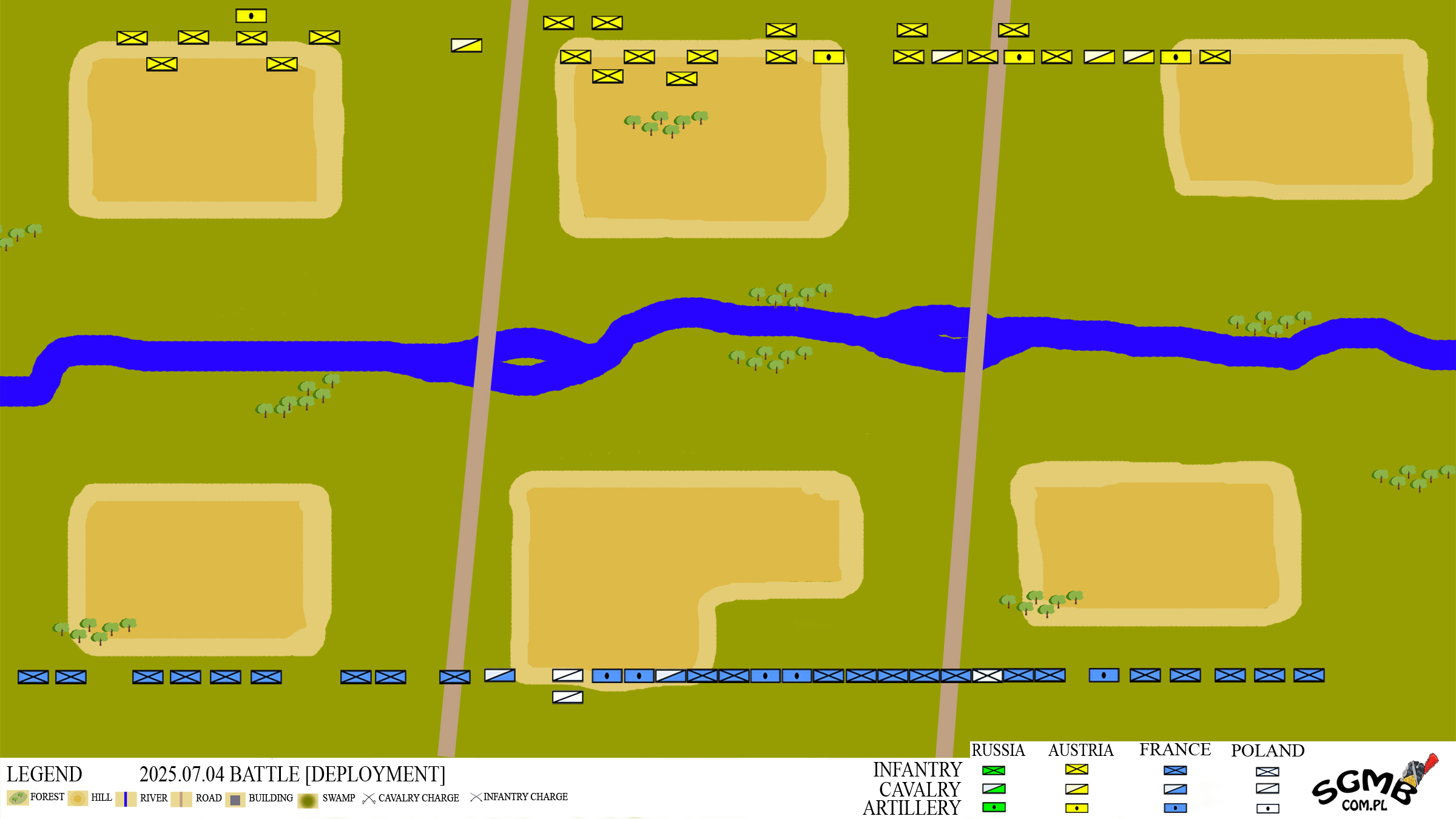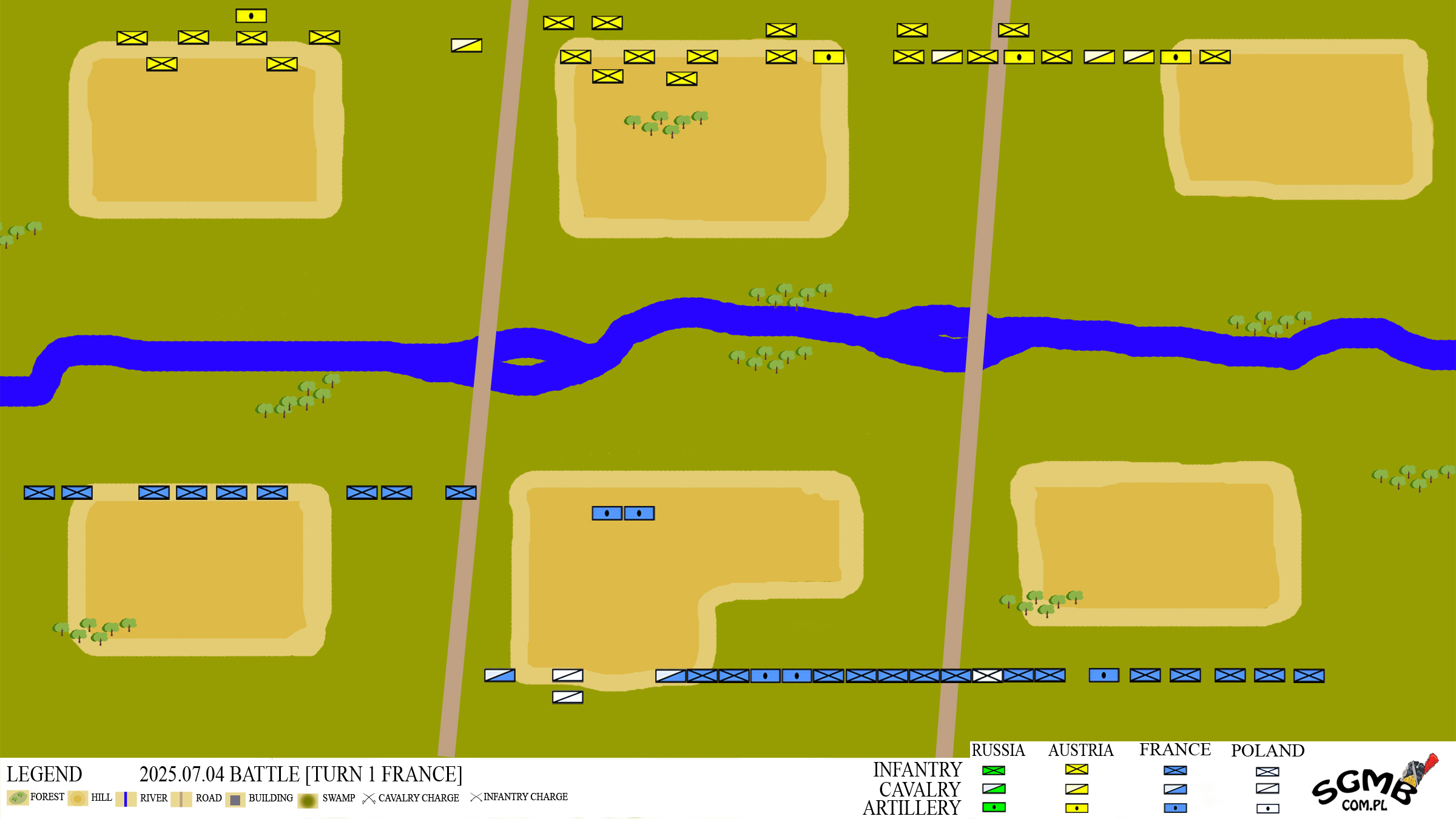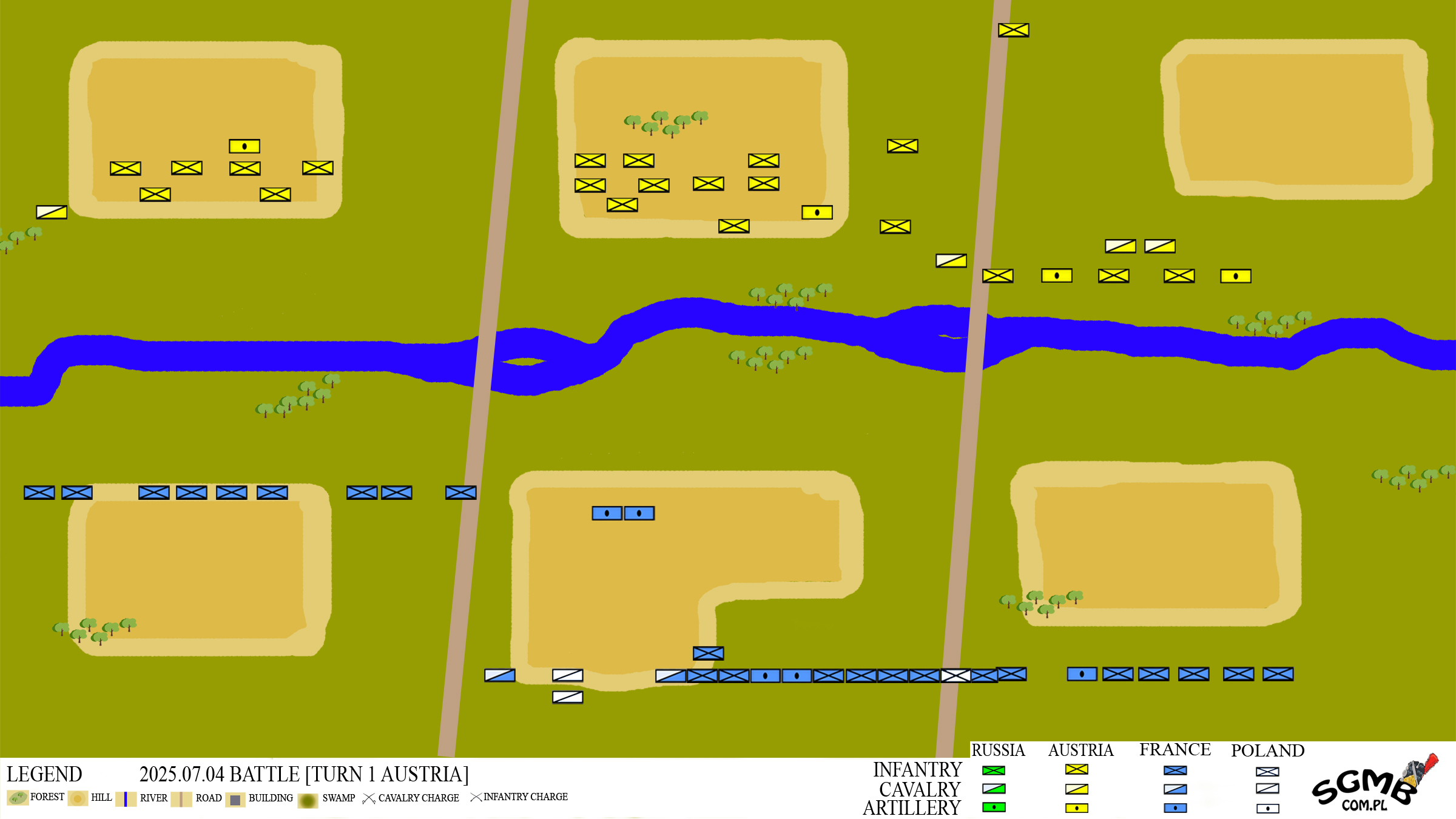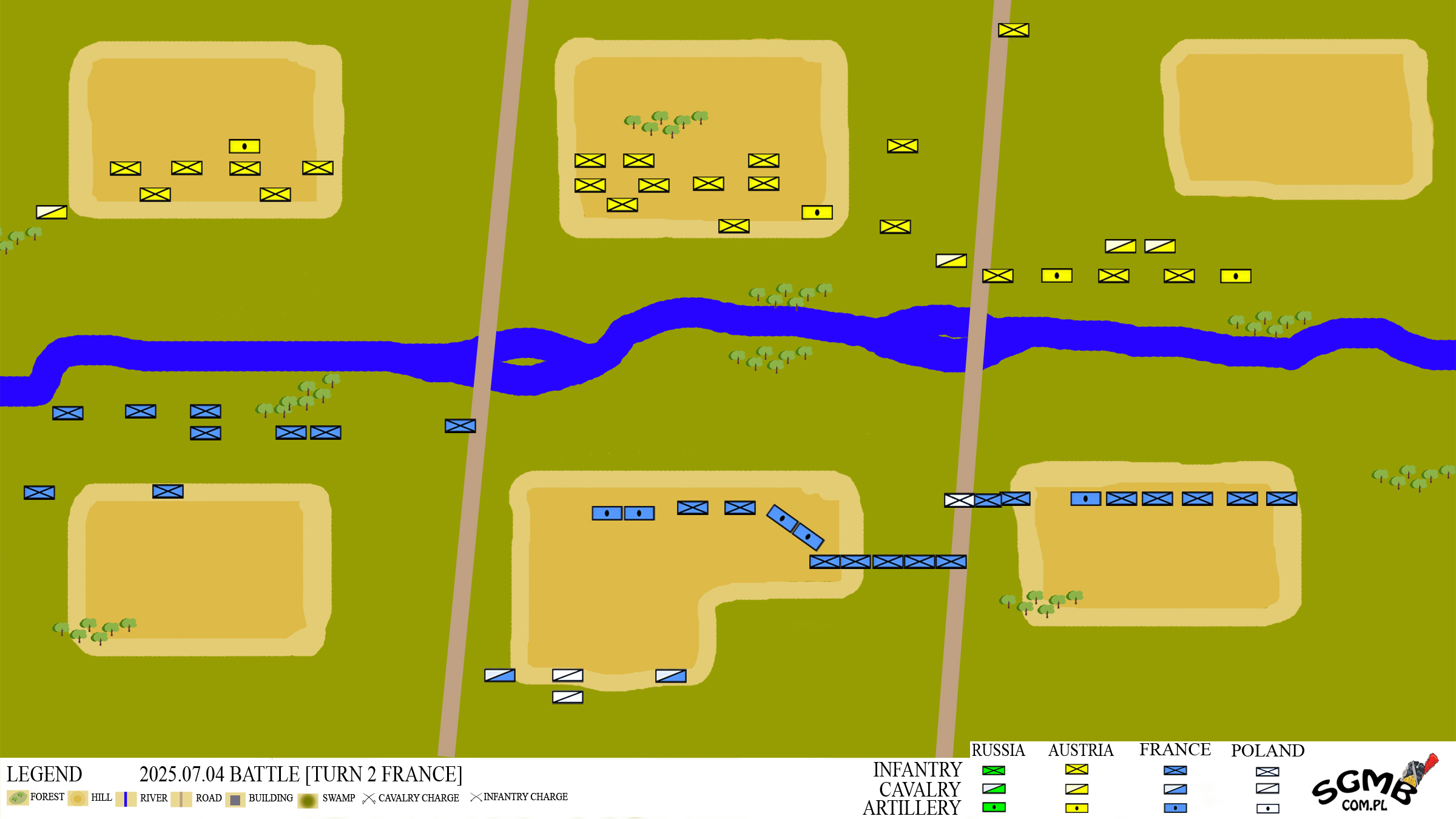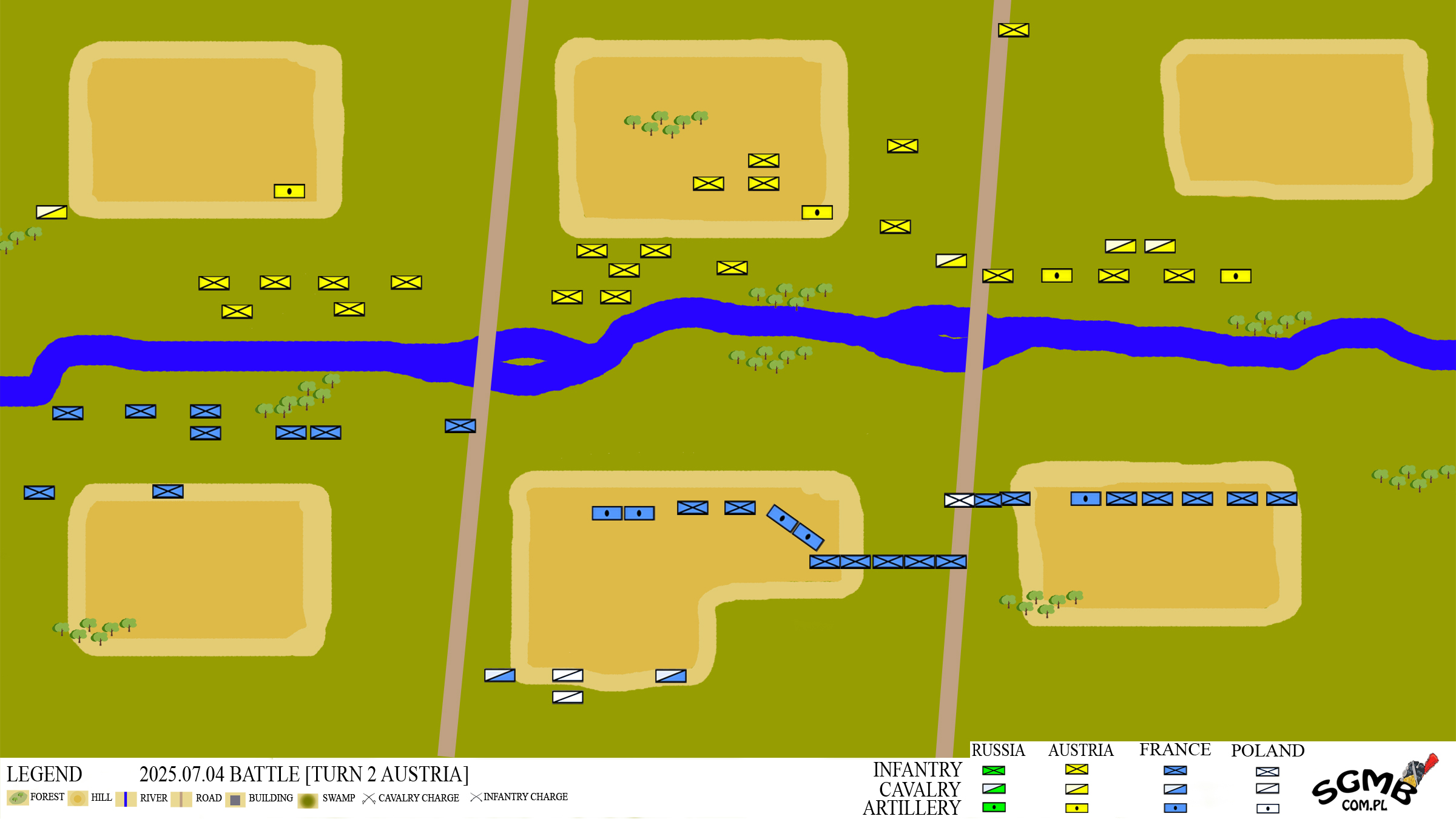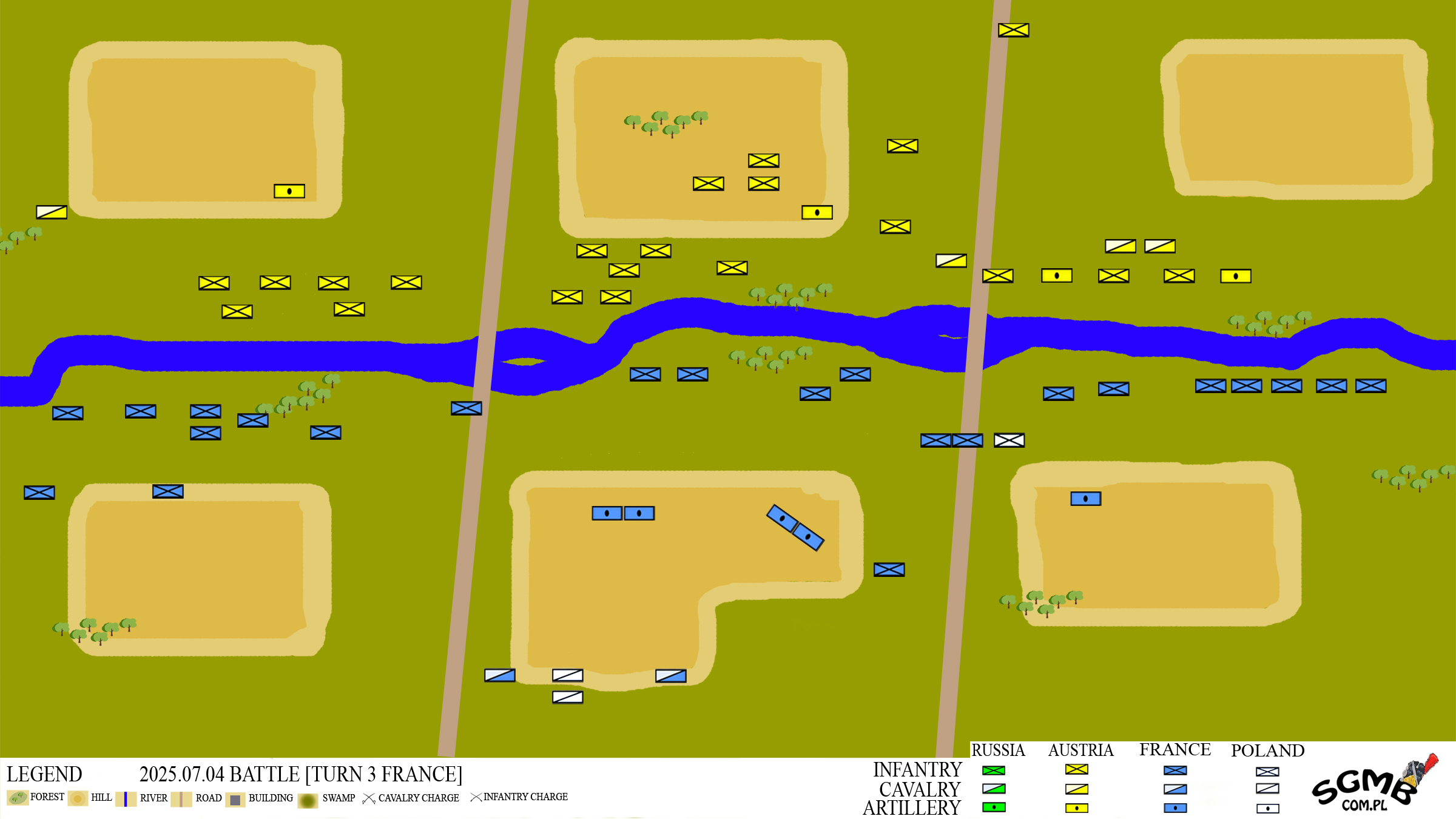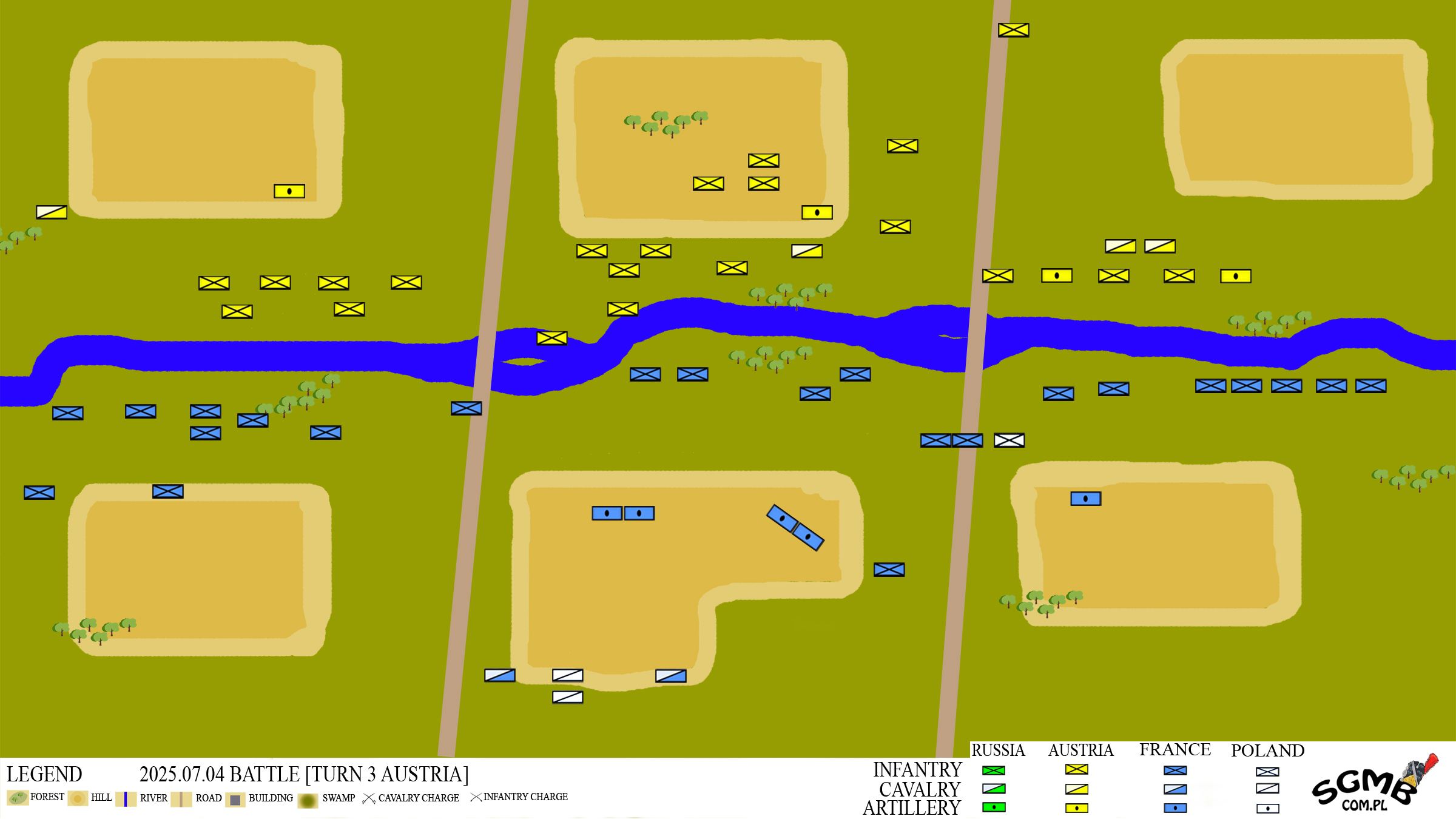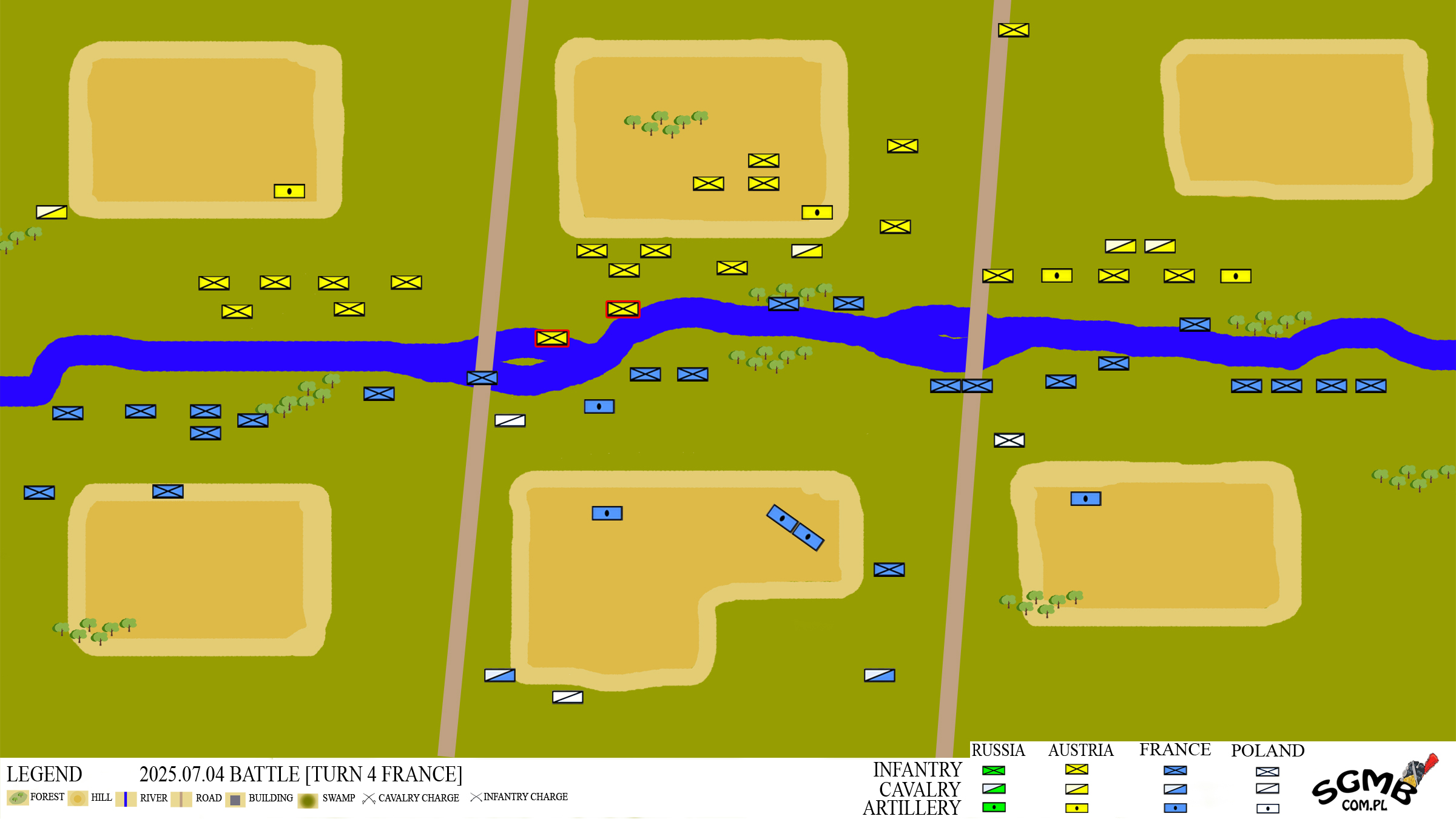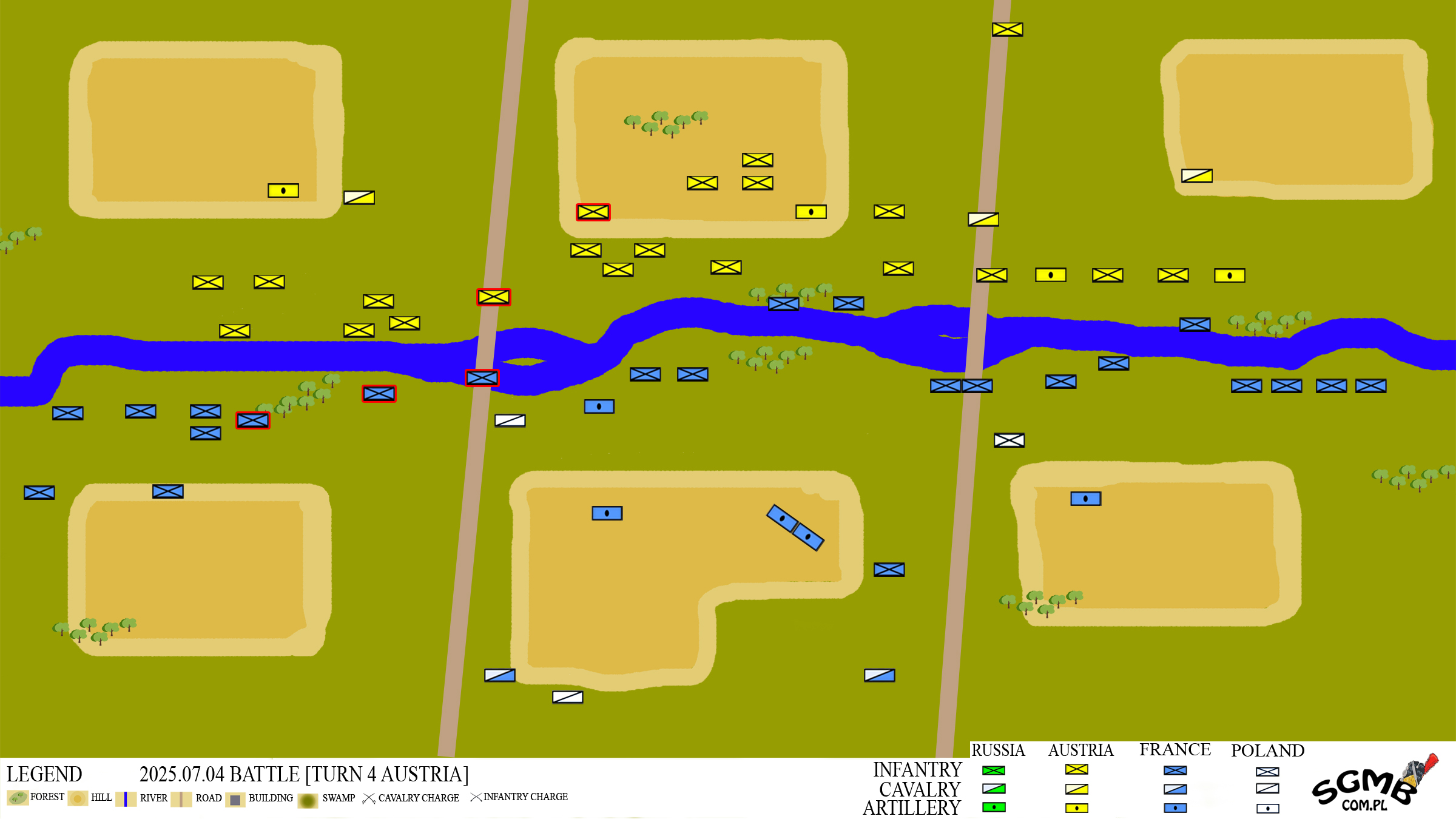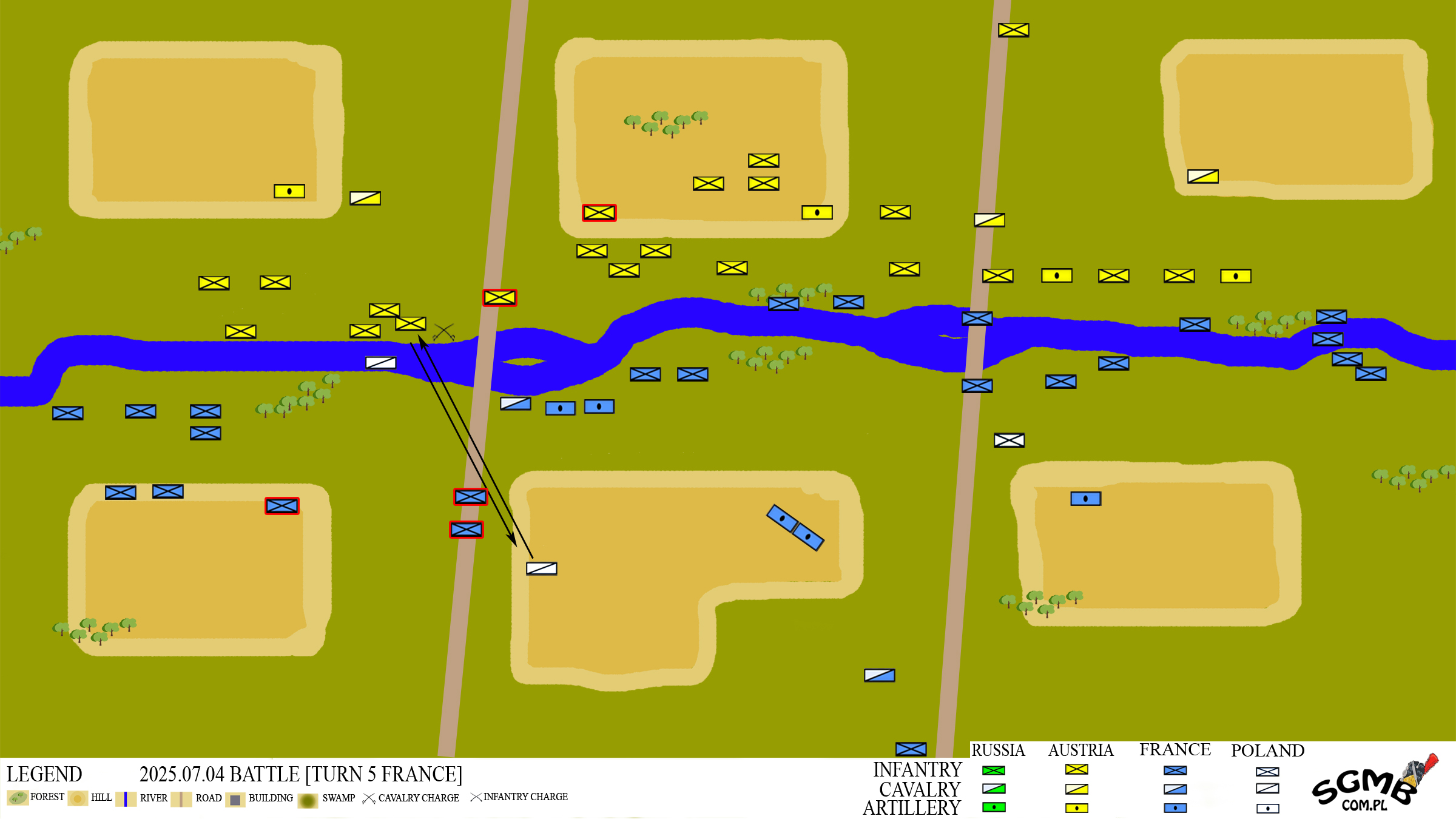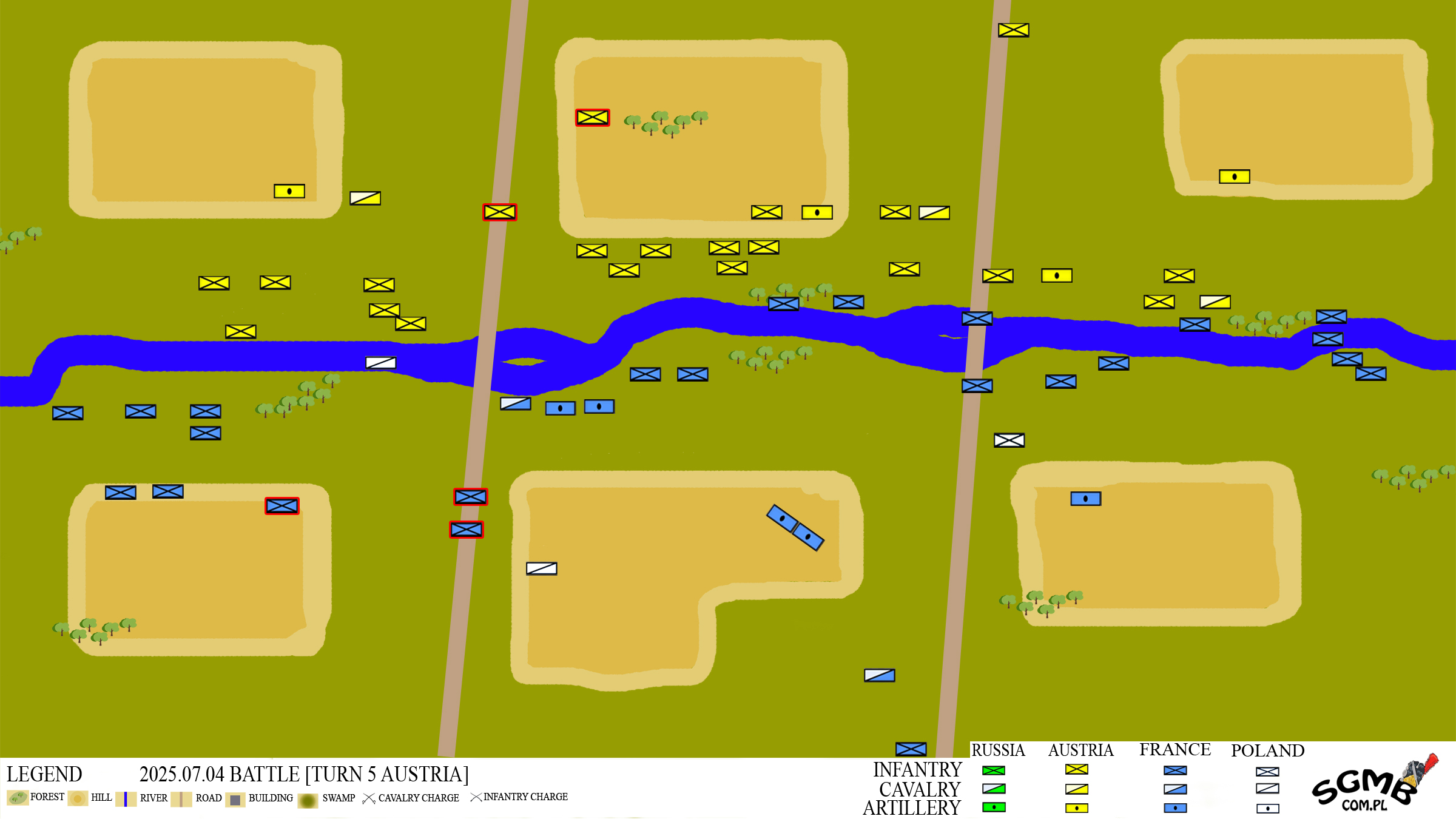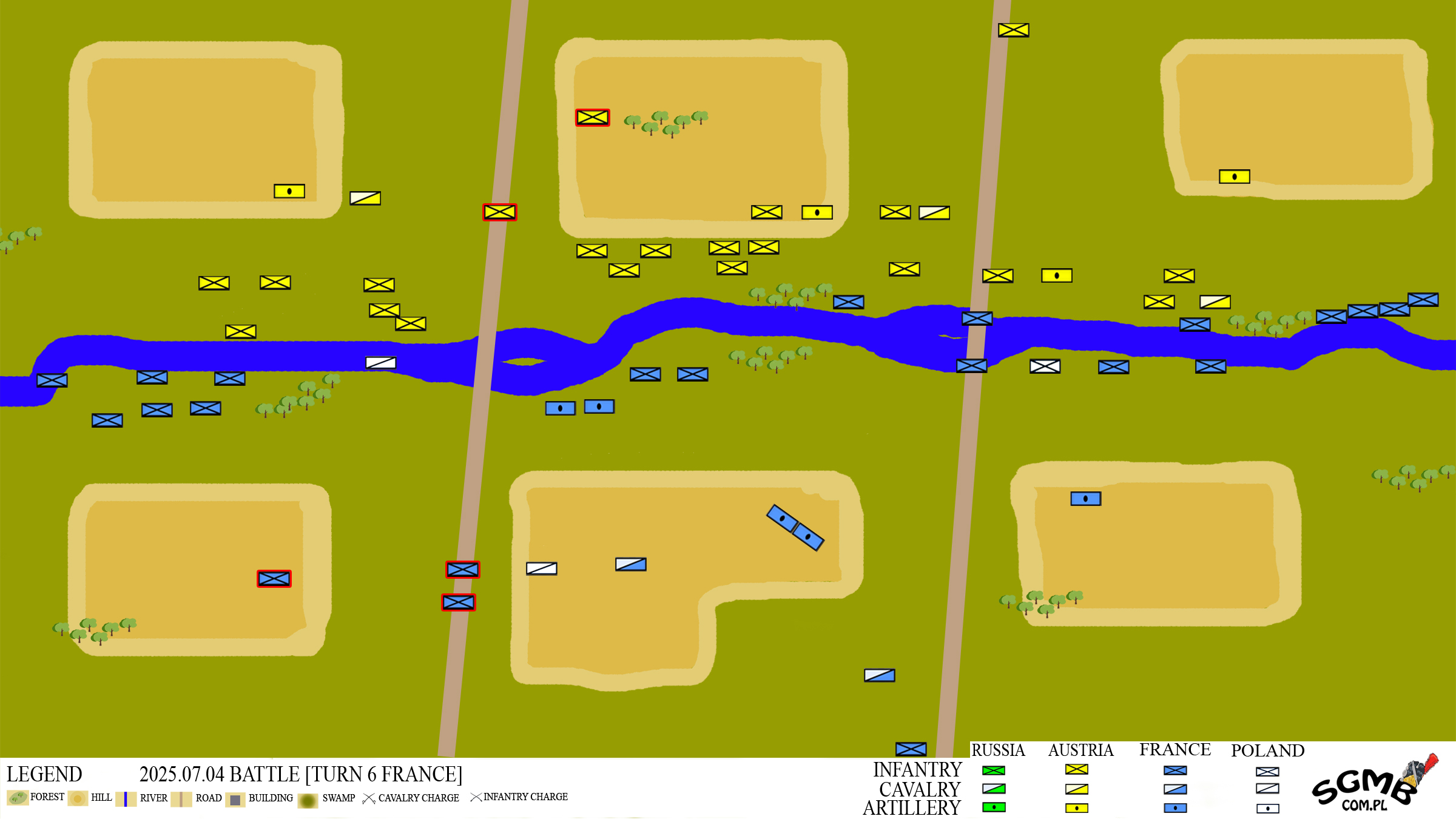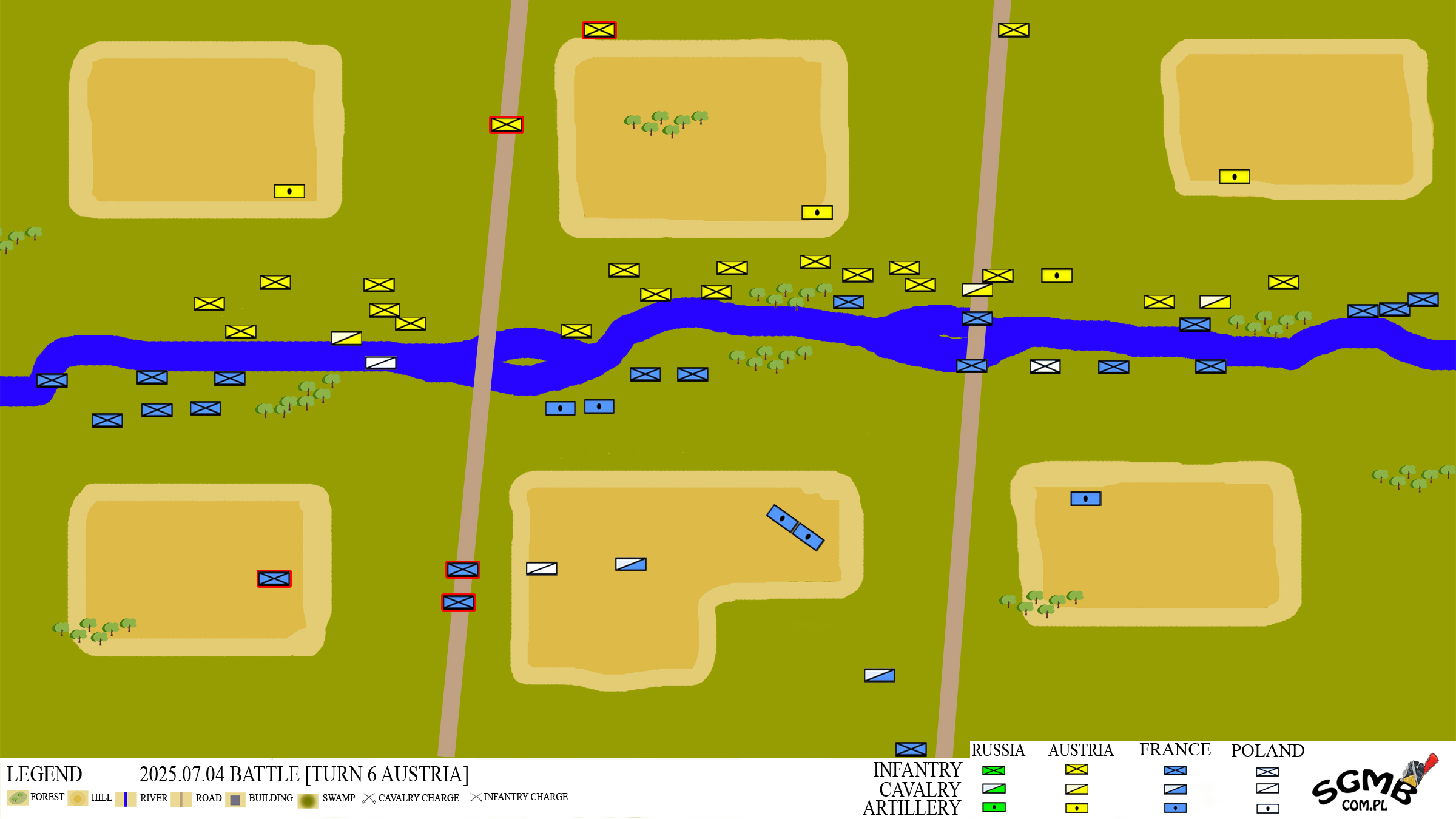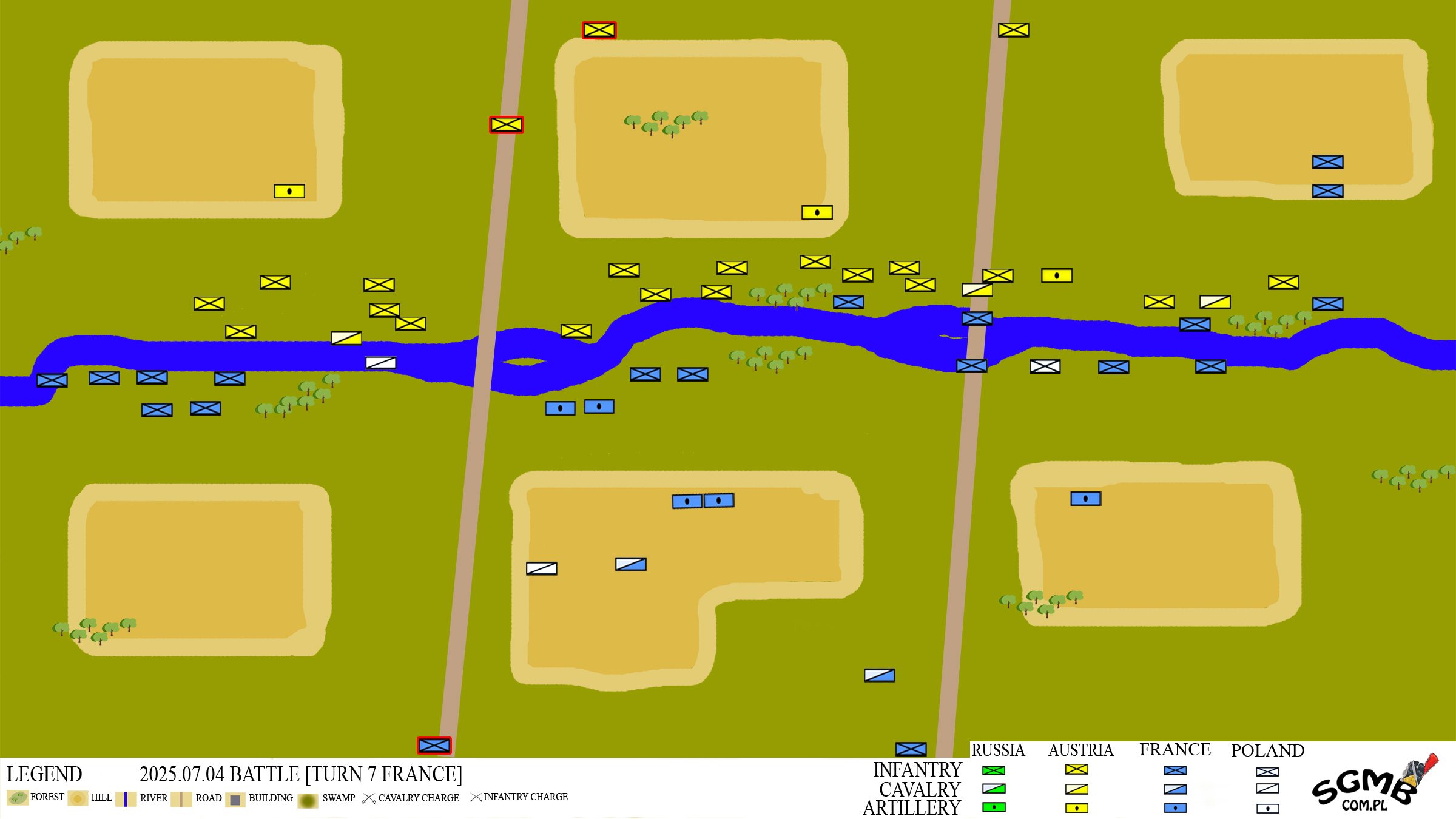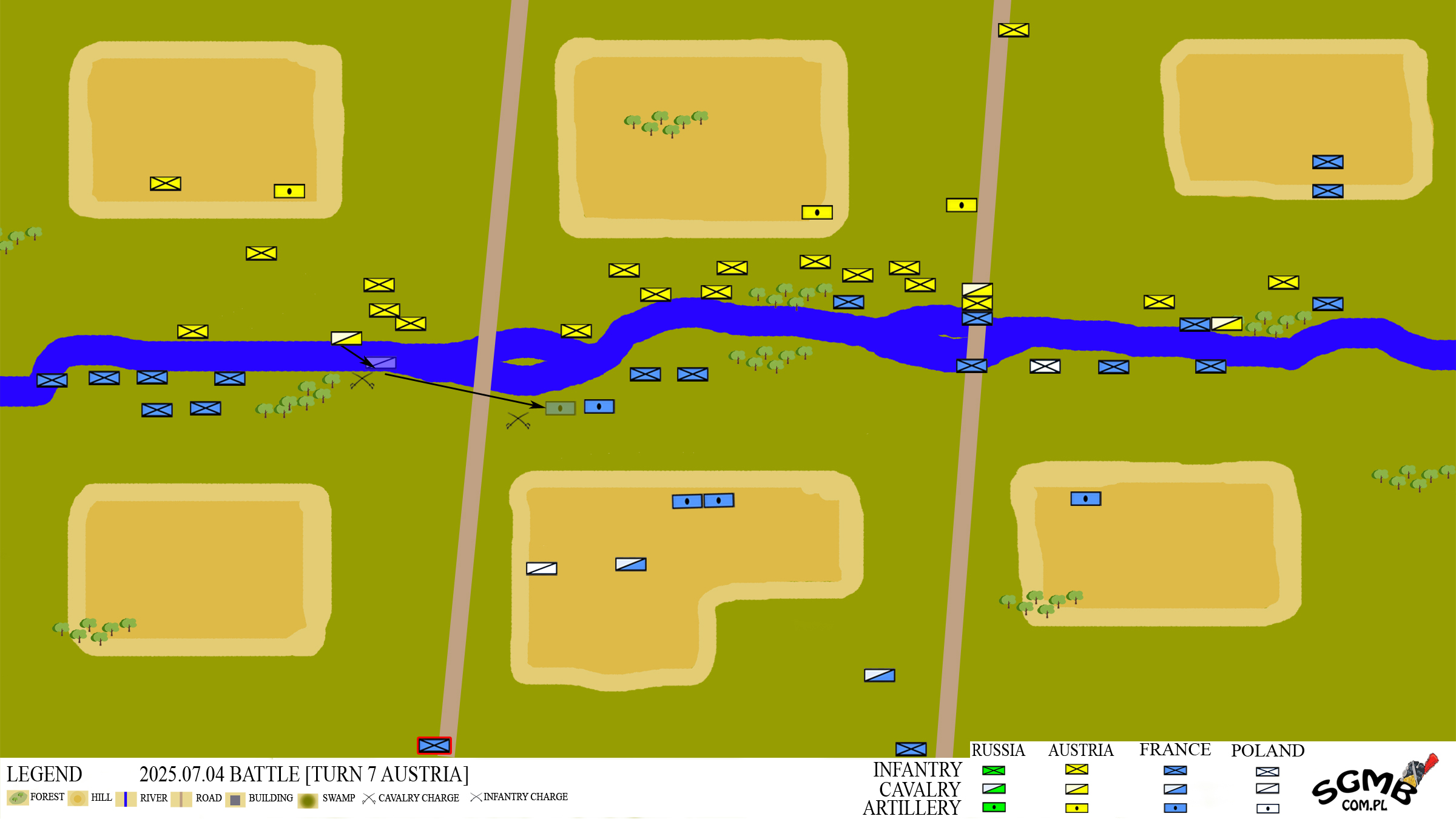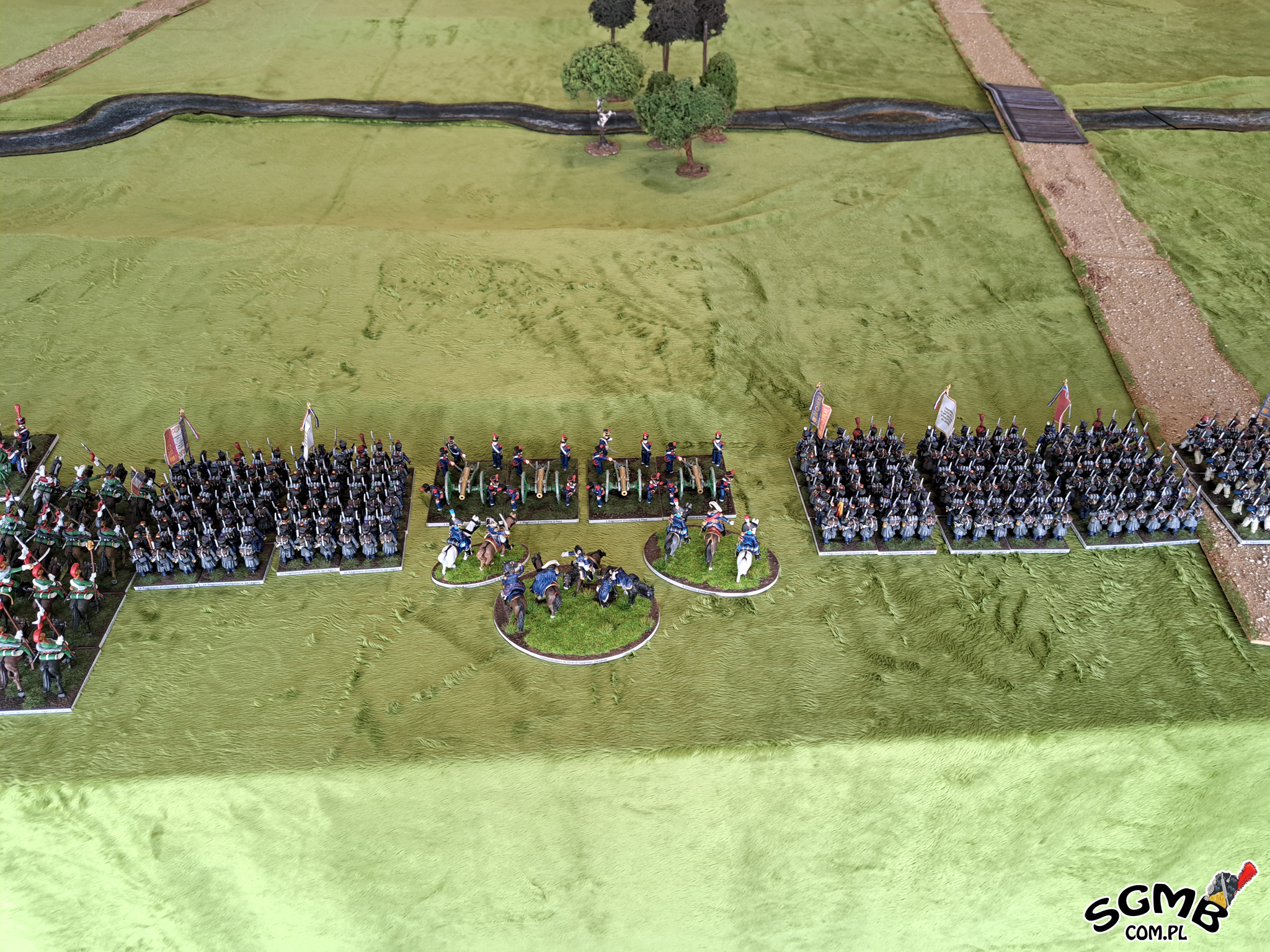
Rozstawienie wojsk Francusko-Polskich w centrum przed bitwą.
Deployment of Franco-Polish troops in centre before the battle.
Rozstawienie wojsk Francusko-Polskich w centrum przed bitwą.
Deployment of Franco-Polish troops in centre before the battle.
|
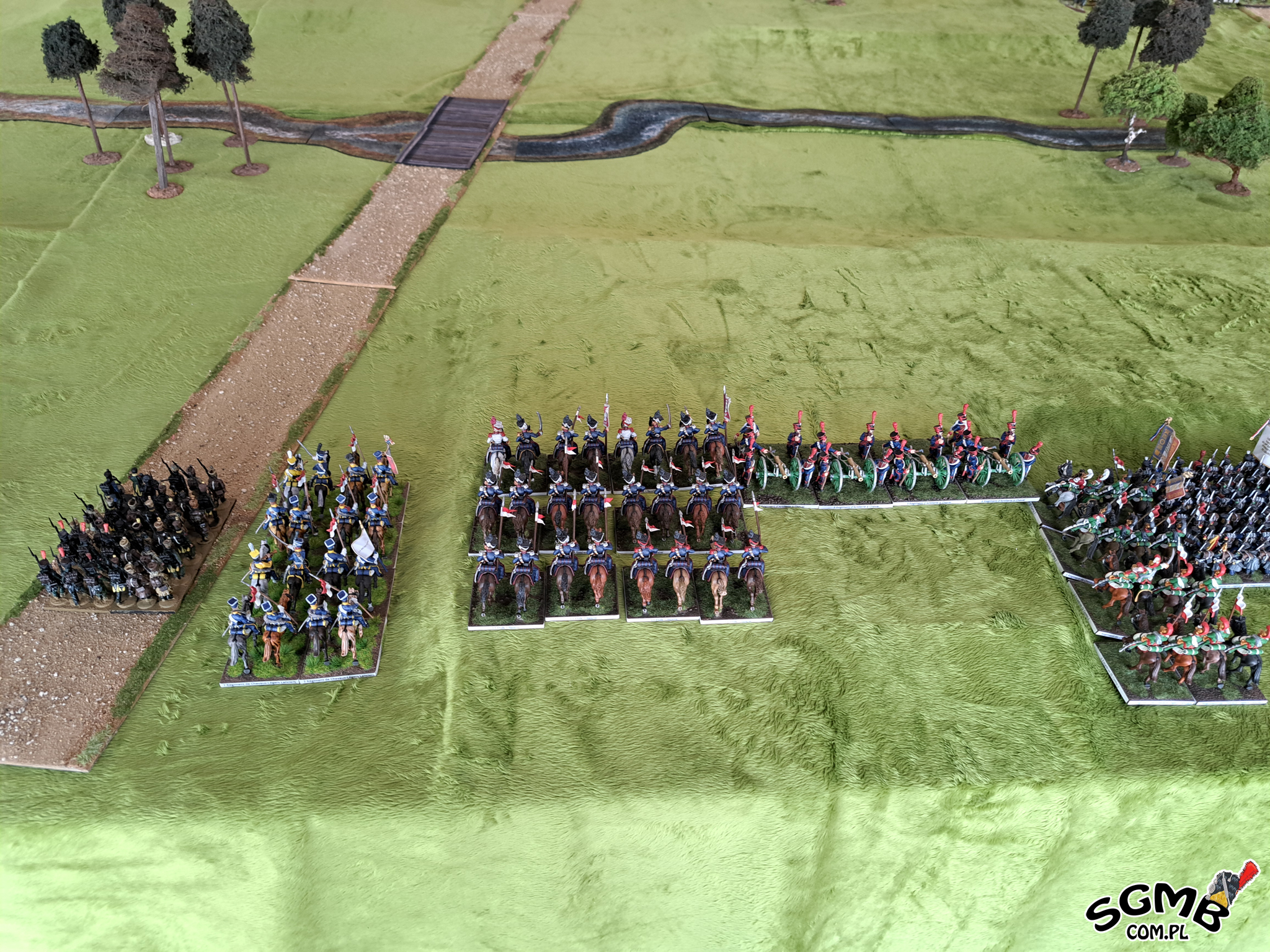
Rozstawienie wojsk Francusko-Polskich w centrum przed bitwą.
Deployment of Franco-Polish troops in centre before the battle.
Rozstawienie wojsk Francusko-Polskich w centrum przed bitwą.
Deployment of Franco-Polish troops in centre before the battle.
|
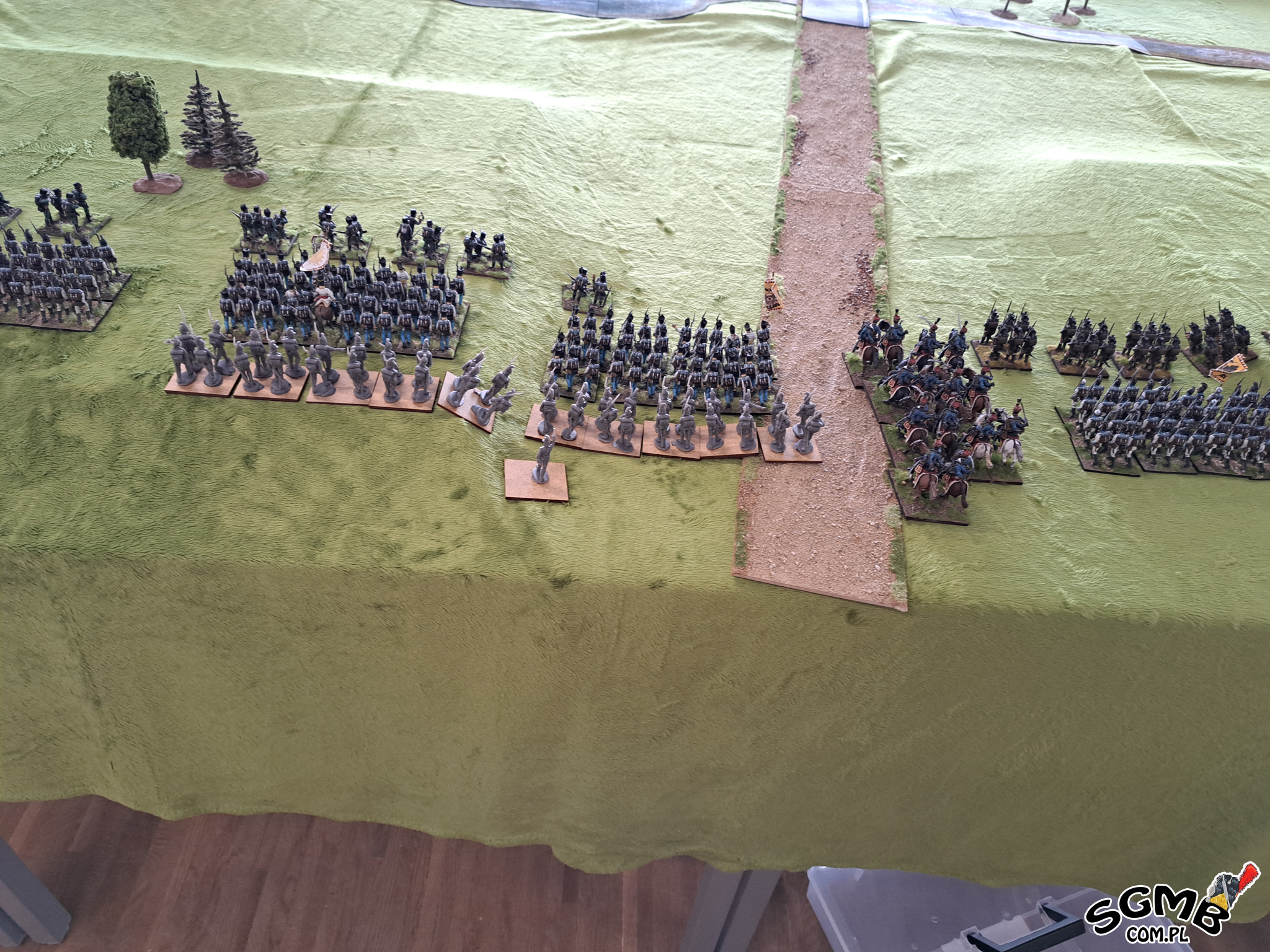
Rozstawienie wojsk Austriacko-Wirtemberskich w centrum przed bitwą.
Deployment of the Austrian-Württemberg troops in the center before the battle.
Rozstawienie wojsk Austriacko-Wirtemberskich w centrum przed bitwą.
Deployment of the Austrian-Württemberg troops in the center before the battle.
|
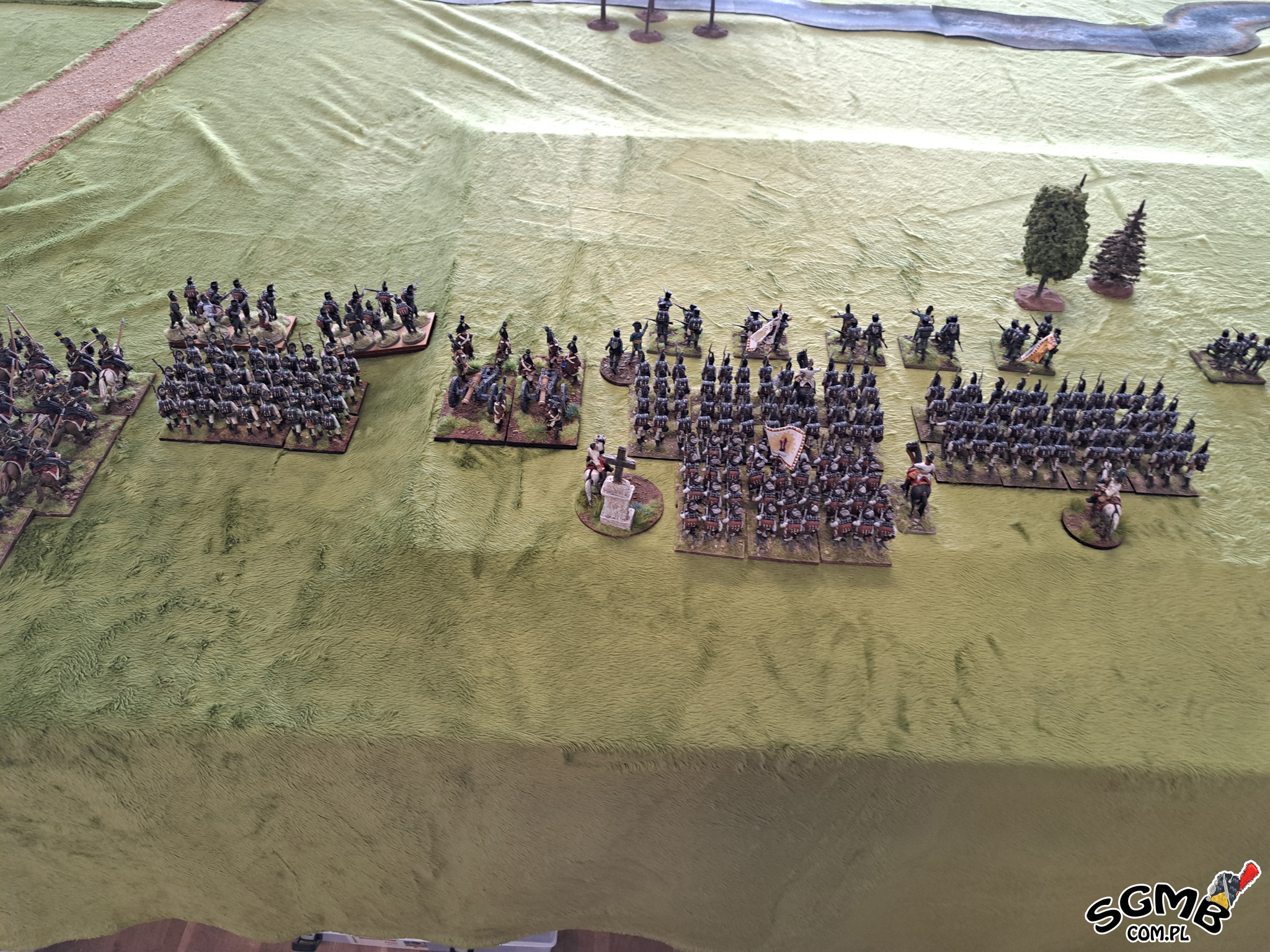
Rozstawienie wojsk Austriacko-Wirtemberskich w centrum przed bitwą.
Deployment of the Austrian-Württemberg troops in the center before the battle.
Rozstawienie wojsk Austriacko-Wirtemberskich w centrum przed bitwą.
Deployment of the Austrian-Württemberg troops in the center before the battle.
|
Bitwę rozpoczęli Francuzi. Jednak w wyniku niedostarczenia na czas rozkazów prawie cała 6 dywizja nie ruszyła się z miejsc. 9 Dywizja podeszła nieznacznie do przodu ustawiając się na wzgórzu i niedaleko brodu.
Bardziej doświadczeone jednostki Austriackie ruszyły w przód z animuszem. Przed szeregi wypuszczając Jegrów i Graniczników.
W odpowiedzi na to Francuzi ruszyli do przodu, działa zajęły dogodne miejsca do strzału i rozpoczęły kanonadę. Jednak na razie bez rezultatu.
Widząc to dowódca Austriacki pchnął do przodu do potyczek ogniowych swoich Jegrów i Graniczników a także dwa bataliony piechoty Wirtemberskiej.
|
The French began the battle. However, due to the failure to deliver orders in time, almost the entire 6th Division remained stationary. The 9th Division advanced slightly, positioning itself on a hill near a ford.
The more experienced Austrian units advanced with gusto, deploying their Jaegers and Border Guards in front of the lines.
In response, the French advanced, their guns took advantage of their firing positions, and began a barrage. However, to no avail.
Seeing this, the Austrian commander pushed forward his Jaegers and Border Guards, as well as two battalions of Württemberg infantry, into firefights.
|
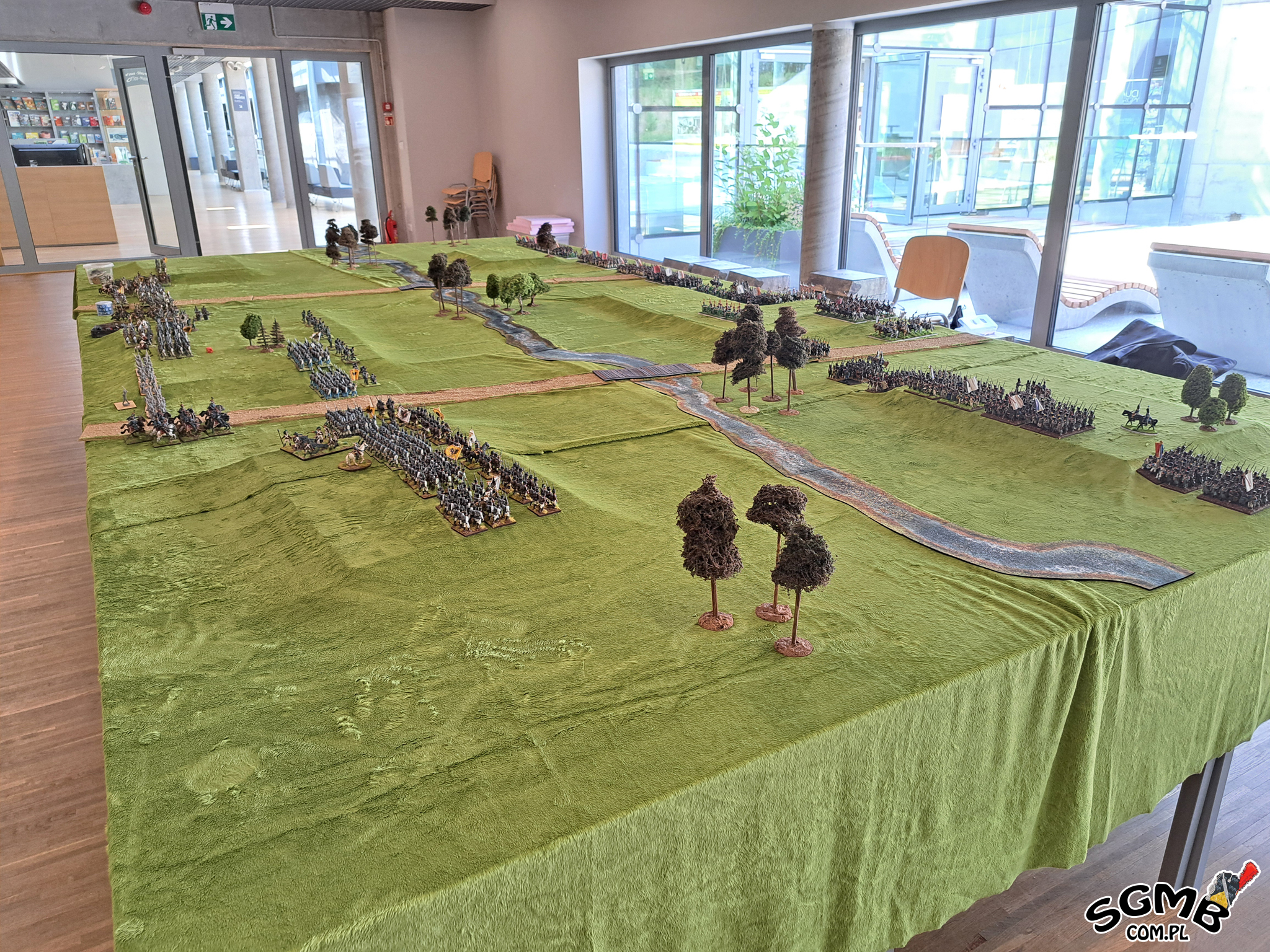
Tura 1. Po ruchach obu armii.
Turn 1. After the movements of both armies.
Tura 1. Po ruchach obu armii.
Turn 1. After the movements of both armies.
|
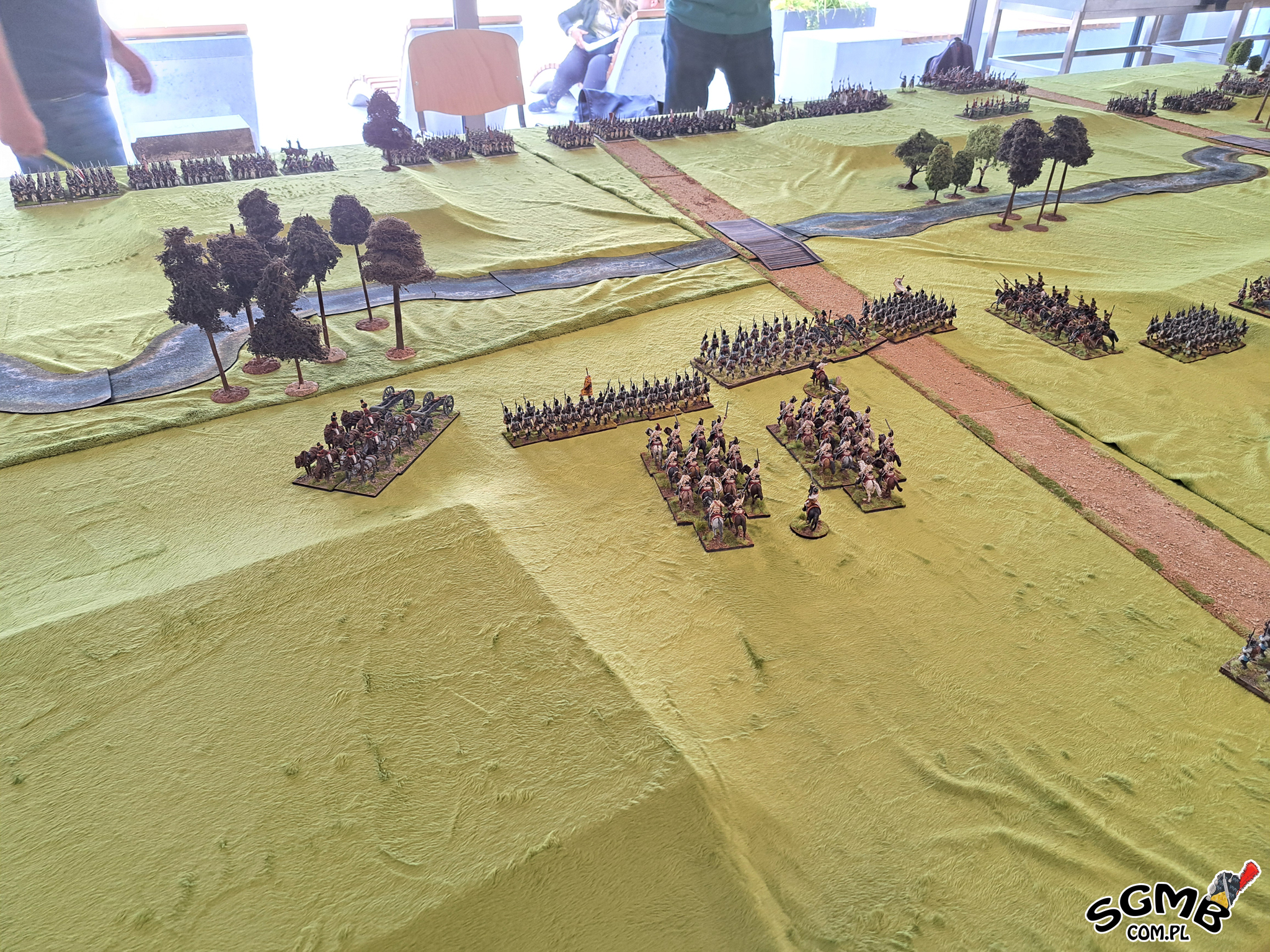
Tura 1. Po ruchach obu armii.
Turn 1. After the movements of both armies.
Tura 1. Po ruchach obu armii.
Turn 1. After the movements of both armies.
|
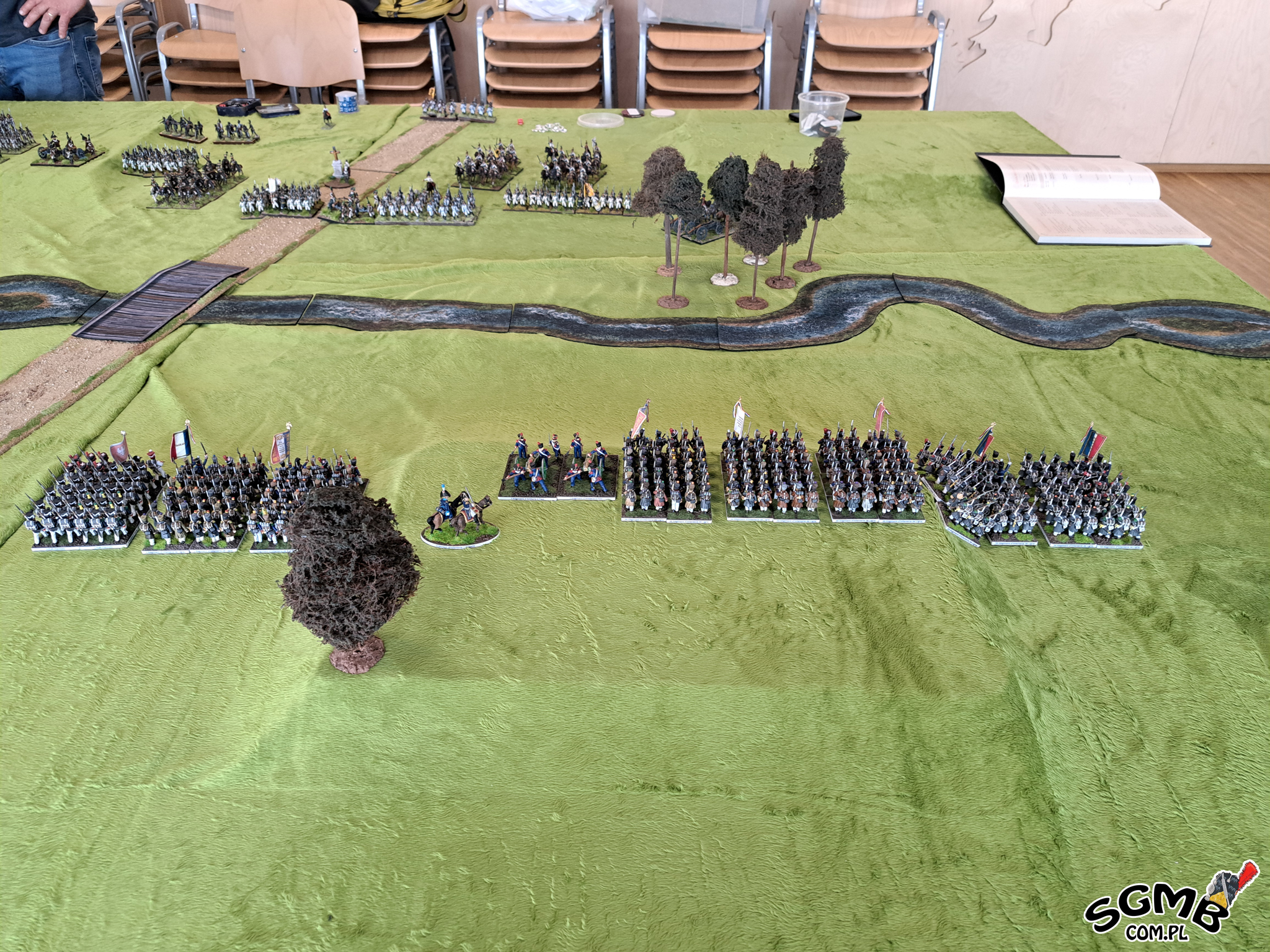
Tura 2. Francuskie prawe skrzydło powoli posunęło się naprzód.
Turn 2. The French right wing slowly advanced.
Tura 2. Francuskie prawe skrzydło powoli posunęło się naprzód.
Turn 2. The French right wing slowly advanced.
|
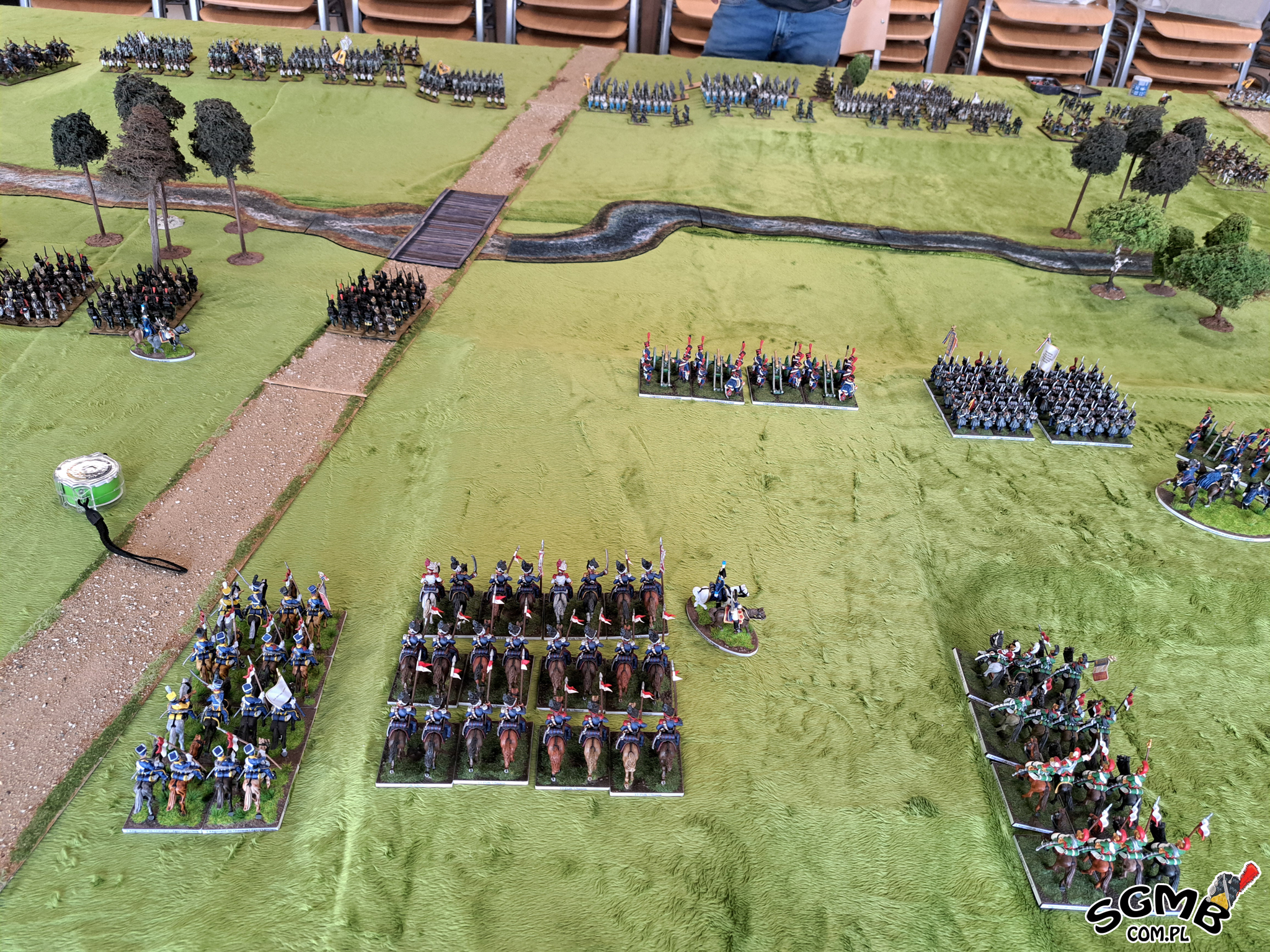
Tura 2. Francuskie centrum i lewe skrzydło powoli posunęło się naprzód. Jednak bez lekkiej jazdy. Jak się później okaże, nie miała ona dzisiaj ochoty do walki.
Turn 2. The French center and left wing slowly advanced. However, without the light cavalry. As it would later turn out, they were in no mood for combat today.
Tura 2. Francuskie centrum i lewe skrzydło powoli posunęło się naprzód. Jednak bez lekkiej jazdy. Jak się później okaże, nie miała ona dzisiaj ochoty do walki.
Turn 2. The French center and left wing slowly advanced. However, without the light cavalry. As it would later turn out, they were in no mood for combat today.
|
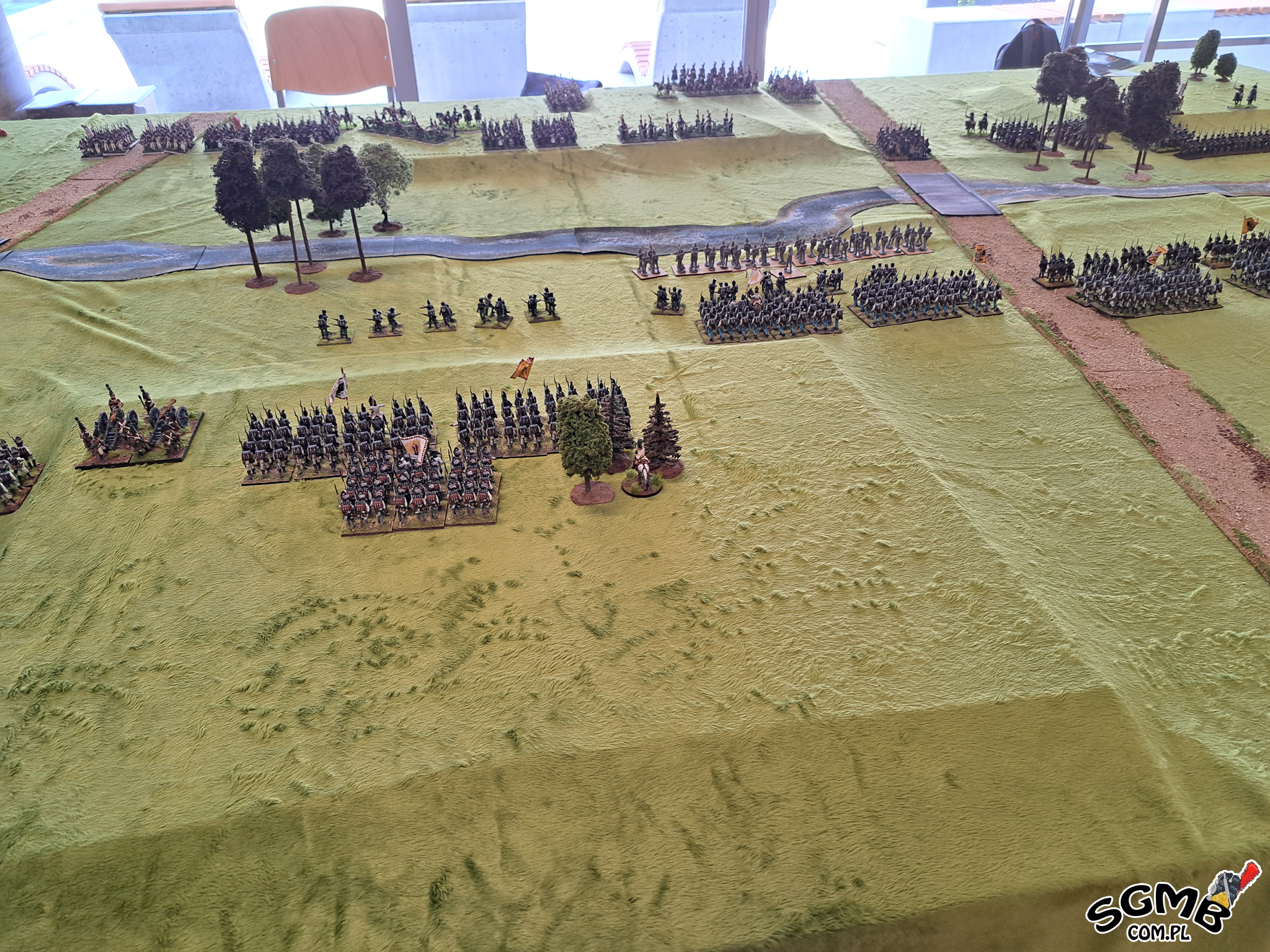
Tura 2. Jak widać austriacy posuwali się szybciej.
Turn 2. As you can see, the Austrians were moving faster.
Tura 2. Jak widać austriacy posuwali się szybciej.
Turn 2. As you can see, the Austrians were moving faster.
|
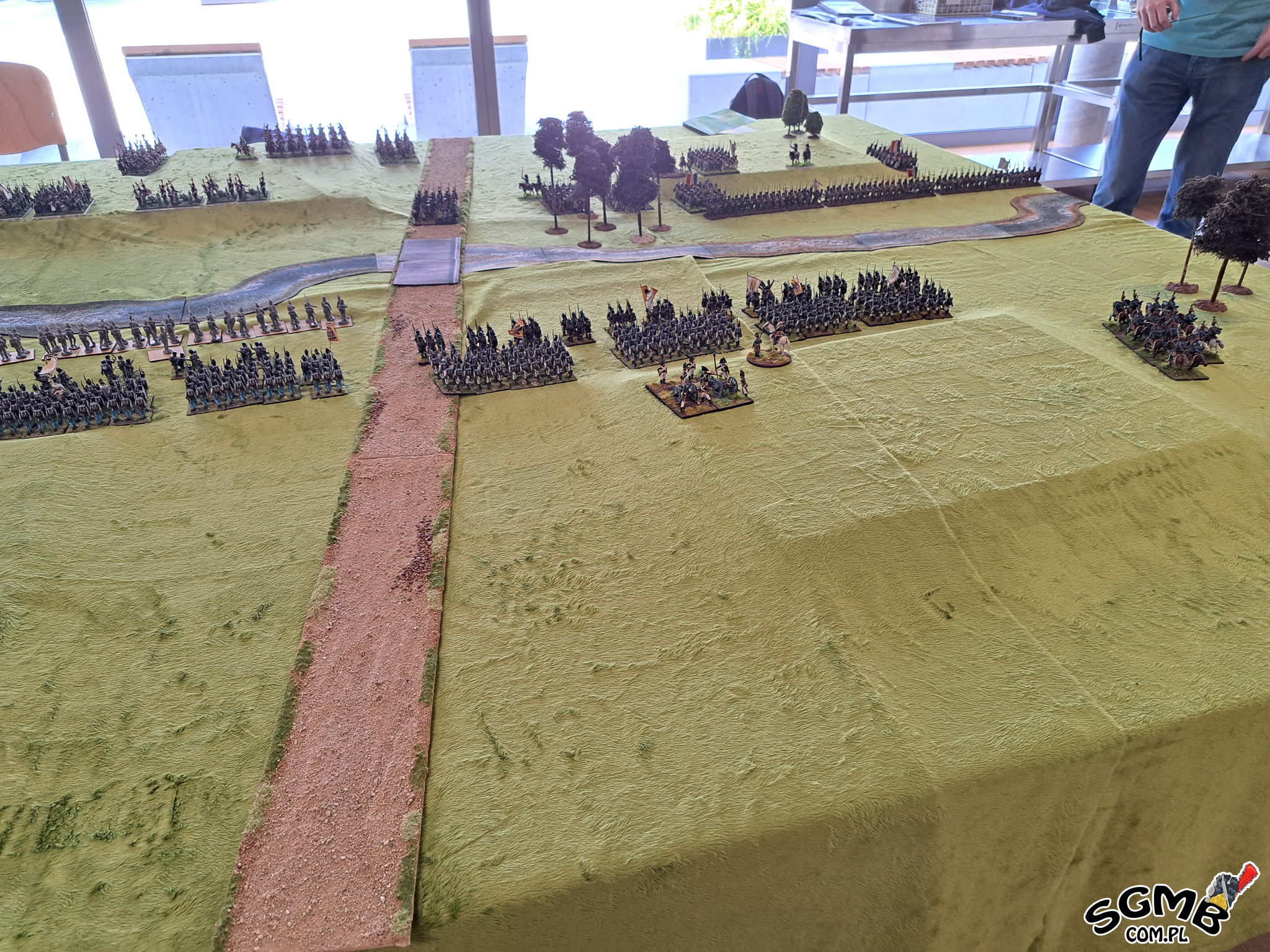
Tura 2. Jak widać austriacy posuwali się szybciej.
Turn 2. As you can see, the Austrians were moving faster.
Tura 2. Jak widać austriacy posuwali się szybciej.
Turn 2. As you can see, the Austrians were moving faster.
|
Bitwa rozgorzała na dobre, gdy do rzeki podeszły Francuskie bataliony lekkie, wdając się w wymianę ognia z Austriackimi Jegrami i Wirtemberczykami. Zza pleców Lekkiej piechoty celnie strzelała artyleria konna z brygady lekkiej kawalerii co mocno odczuli to Wirtemberczycy.
Na prawym skrzydle bataliony przygotowane do przekroczenia rzeki aby oskrzydlić Austiaków nie mogły wykonać rozkazów, przez co odsunęła się wizja szybkiego oskrzydlenia i być możne nawet okrążenia części ich sił.
Dowódca sił Francuskich wiedząc, że pod komendą ma głównie świerzych rekrutów ale pełnych zapału był też świadom, że na przeciw stoją zaprawione w bojach pełne weteranów wojska przeciwnika. Dlatego wolał zaufać manewrowi niż frontalnym atakom na bagnety.
Austriacy też ostrożnie podeszli do bitwy. Do tej pory najwięcej pracy miała artyleria i Jegrzy. Pchnięta do przodu brygada Wirtemberska zatrzymała się na środku rzeki.
|
The battle raged in earnest when the French light battalions approached the river, engaging in an exchange of fire with the Austrian Jaegers and Württembergers. Behind the light infantry, horse artillery from the light cavalry brigade fired accurately, which the Württembergers felt strongly.
On the right flank, battalions prepared to cross the river to outflank the Austrians were unable to carry out their orders, thus derailing the prospect of a quick outflanking and perhaps even encircling part of their forces.
The commander of the French forces, knowing that he had mostly fresh recruits under his command but full of enthusiasm, was also aware that the enemy, battle-hardened and full of veterans, faced them. Therefore, he preferred to rely on maneuver rather than frontal bayonet attacks.
The Austrians also approached the battle cautiously. Up to this point, the artillery and Jaegers had had the most work. The Württemberg brigade, pushed forward, stopped in the middle of the river.
|
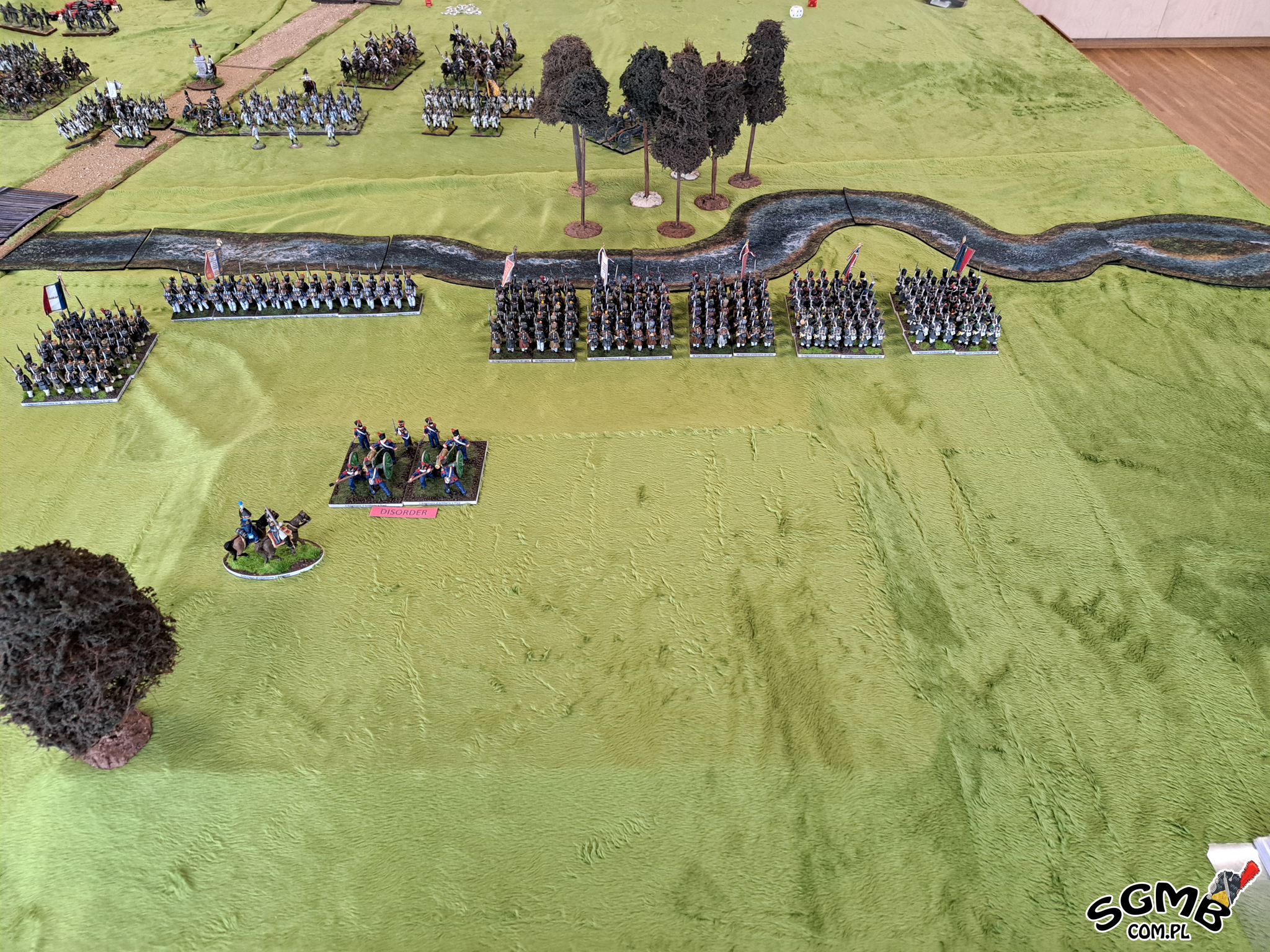
Tura 3. Bataliony Francuskie nawiązały kontakt z przeciwnikiem i rozpoczęły walkę ogniową.
Turn 3. The French Battalions made contact with the enemy and began a firefight.
Tura 3. Bataliony Francuskie nawiązały kontakt z przeciwnikiem i rozpoczęły walkę ogniową.
Turn 3. The French Battalions made contact with the enemy and began a firefight.
|
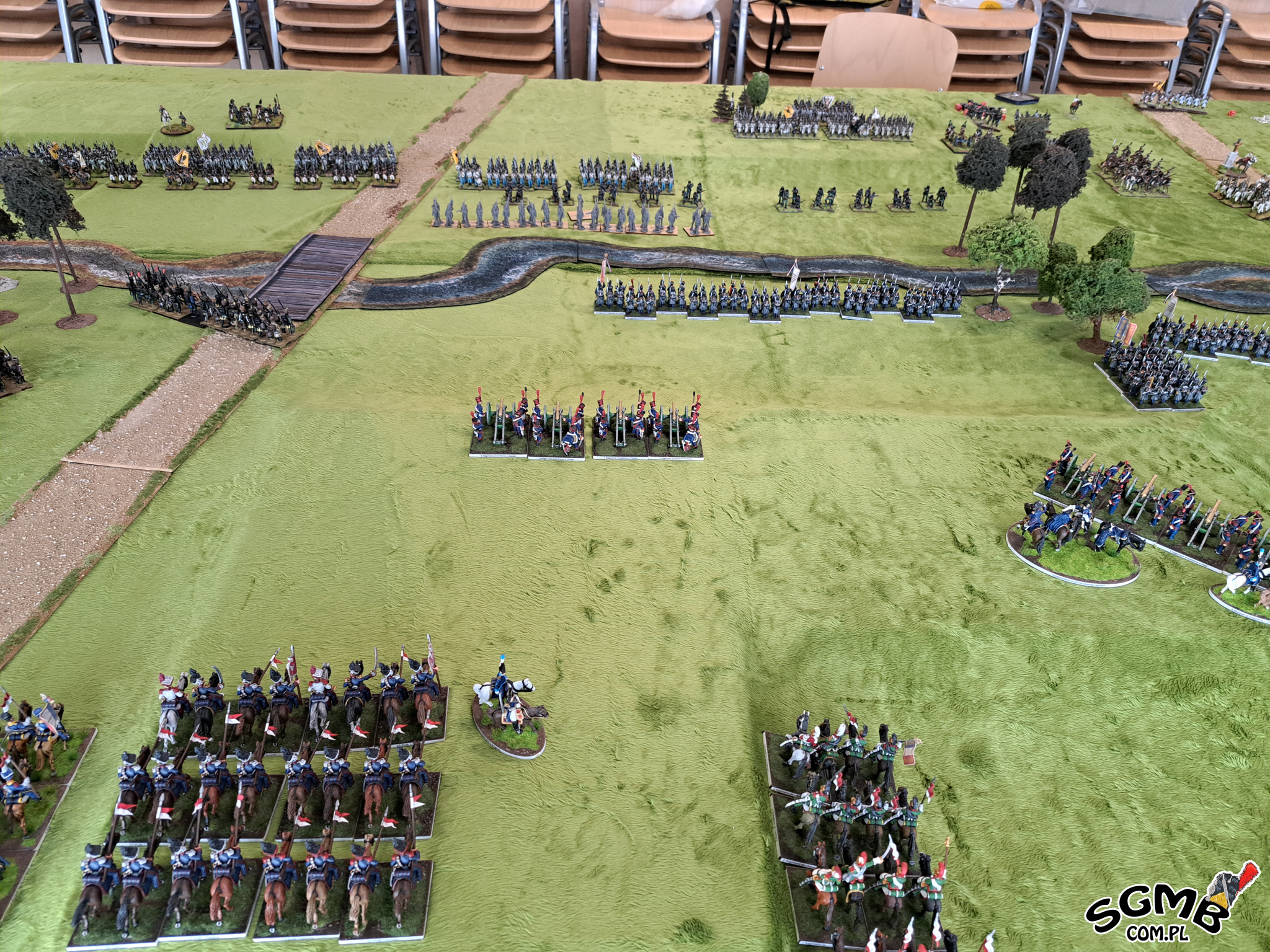
Tura 3. Bataliony Francuskie nawiązały kontakt z przeciwnikiem i rozpoczęły walkę ogniową.
Turn 3. The French Battalions made contact with the enemy and began a firefight.
Tura 3. Bataliony Francuskie nawiązały kontakt z przeciwnikiem i rozpoczęły walkę ogniową.
Turn 3. The French Battalions made contact with the enemy and began a firefight.
|
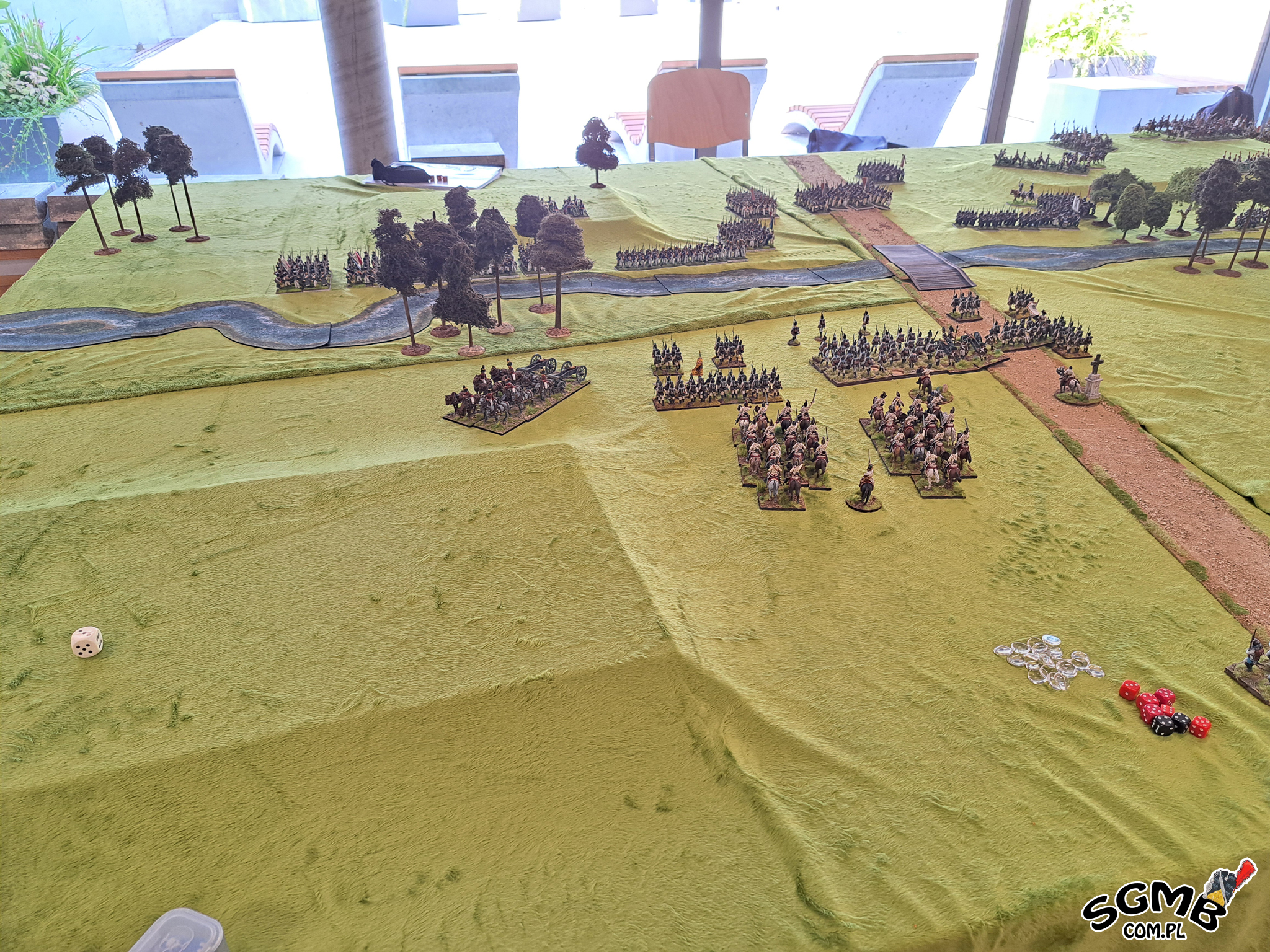
Tura 3. Austriacy w walce ogniowej. Tuż za pierwszą linią czeka ciężka kawaleria.
Turn 3. The Austrians are in a firefight. Heavy cavalry awaits just behind the front line.
Tura 3. Austriacy w walce ogniowej. Tuż za pierwszą linią czeka ciężka kawaleria.
Turn 3. The Austrians are in a firefight. Heavy cavalry awaits just behind the front line.
|

Tura 3. Sytuacja na koniec tury. Rzeka podzieliła obie armie.
Turn 3. The situation at the end of the turn. The river divided the two armies.
Tura 3. Sytuacja na koniec tury. Rzeka podzieliła obie armie.
Turn 3. The situation at the end of the turn. The river divided the two armies.
|
W 4 turze na prawej flance Francuskiej bataliony zbliżyły się do rzeki a pojedyncze zaczęły ją przekraczać. Lekka piechota w centrum ukryła się w lesie i zajęła pozycję po obu jego stronach.
Nie pomagała kawaleria, gdyż do tej pory nie wykonywała rozkazów. Próba szarży na batalion Wirtemberski nie doszła do skutku, gdyż ten zdążył uformować czworobok. Czego nie zrobiła kawaleria, zrobiła piechota i artyleria.
Skuteczny ostrzał rozbił brygadę Wirtemberską.
Widząc, że pojedynki pomiędzy Jegrami a Lekką Piechotą nie dają wymiernych efektów Dowódca Austriacki postanowił pchnąć do przodu jedną z brygad. Rozwinięte w linie duże bataliony przeszły do walki ogniowej wspomagając wysiłki Jegrów.
Zaowocowało to rozbiciem 3batalionowej brygady Francuzów.
W centrum Ułani zostali rzeceni do szarży na batalion lekkiej piechoty francuskiej. Batalion ten rzucił się do ucieczki i uległby całkowitej zagładzie gdyby nie drugi batalion ukryty w lesie.
Ogień z muszkietów do szarżującej kawalerii spowodował jej ucieczkę.
Czas pokaże, że nie był to dobry dzień dla Ułanów/Lansjerów z jednej jak i drugiej strony.
|
In the fourth round, on the French right flank, battalions approached the river, and individual units began crossing it. The light infantry in the center hid in the forest and took up positions on either side.
The cavalry was of no help, as it had not followed orders up to that point. An attempted charge against the Württemberg battalion failed, as it had already formed a square. What the cavalry failed to do, the infantry and artillery did.
The effective firepower routed the Württemberg brigade.
Seeing that the duels between the Jagers and the Light Infantry were yielding no tangible results, the Austrian commander decided to push one of the brigades forward. The large battalions, deployed in lines, engaged in firefights, supporting the Jagers' efforts.
This resulted in the defeat of the 3rd battalion French brigade.
In the center, the Uhlans were ordered to charge against the French light infantry battalion. This battalion fled and would have been completely annihilated if not for the second battalion hidden in the forest.
Musket fire at the charging cavalry caused them to flee.
Time will tell that this was not a good day for the Uhlans/Lancers on either side.
|
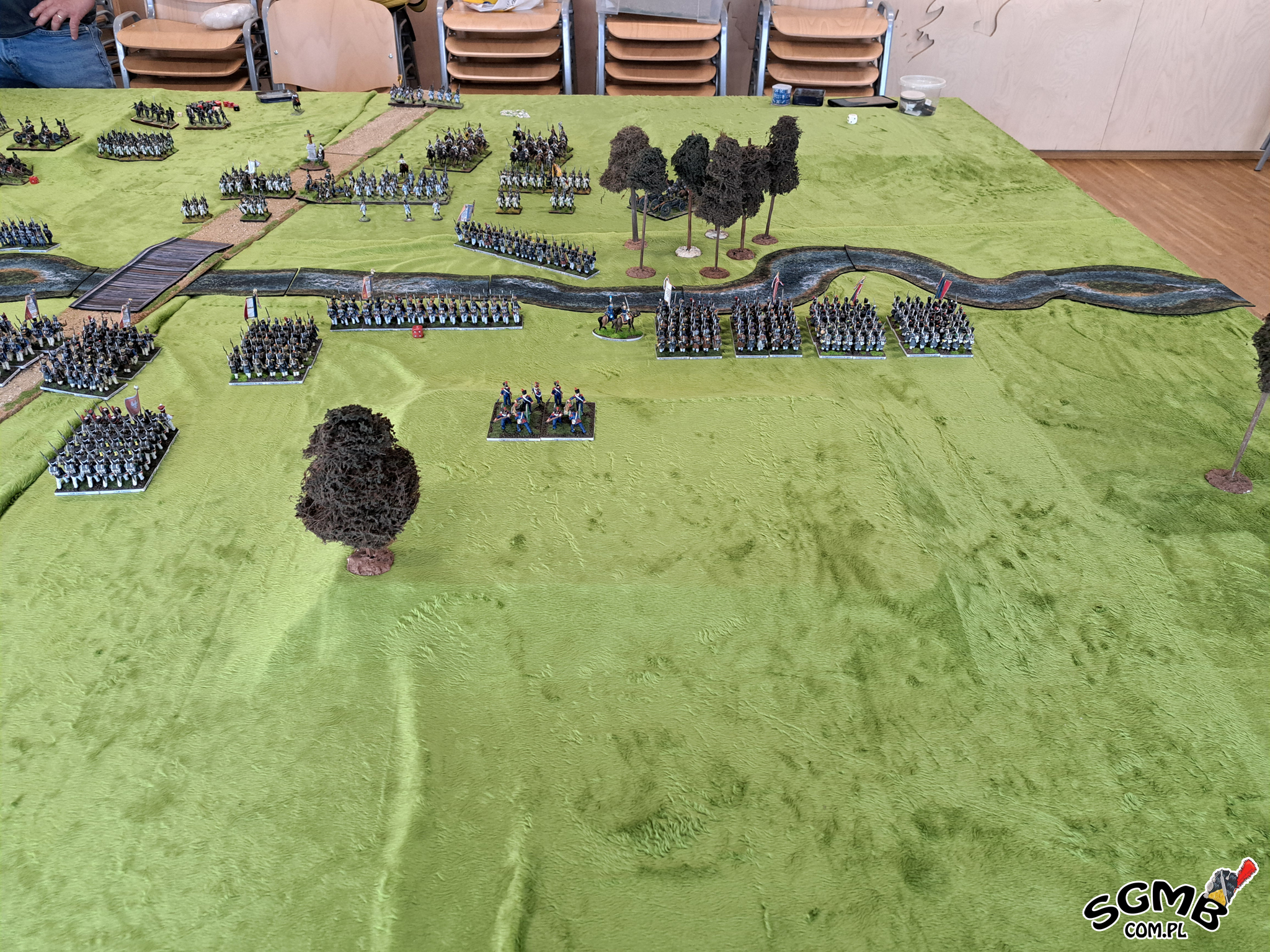
Tura 4. Pojedyncze Francuskie bataliony przekraczają rzekę.
Turn 4. Single French battalions cross the river.
Tura 4. Pojedyncze Francuskie bataliony przekraczają rzekę.
Turn 4. Single French battalions cross the river.
|
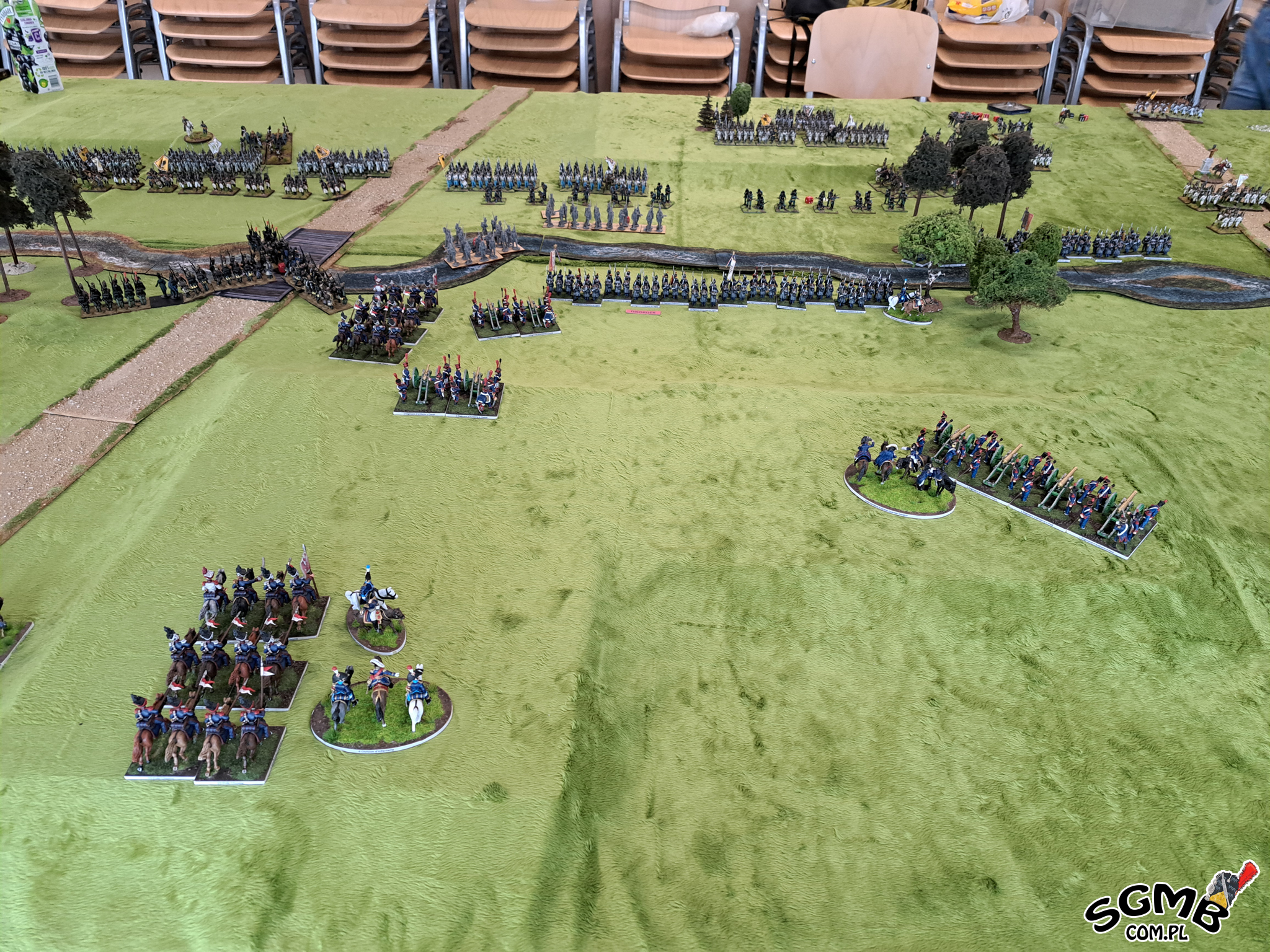
Tura 4. Pojedyncze Francuskie bataliony przekraczają rzekę. Lekka piechota wraz z artylerią konną łamią Brygadę Wirtemberską.
Turn 4. Single French battalions cross the river. Light infantry and horse artillery break the Württemberg Brigade.
Tura 4. Pojedyncze Francuskie bataliony przekraczają rzekę. Lekka piechota wraz z artylerią konną łamią Brygadę Wirtemberską.
Turn 4. Single French battalions cross the river. Light infantry and horse artillery break the Württemberg Brigade.
|
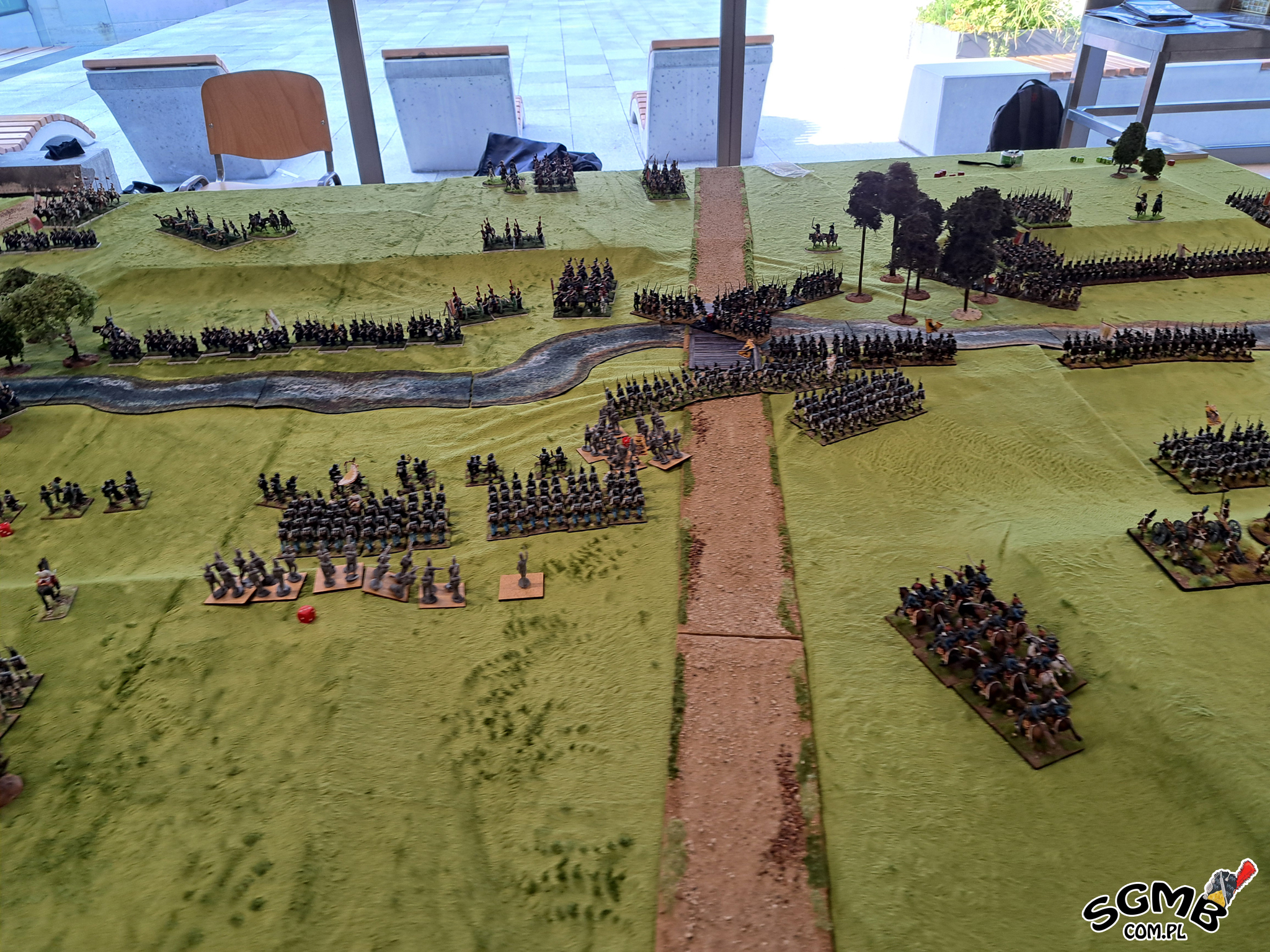
Tura 4. Kolejne Austriackie bataliony zbliżyły się do pozycji Francuskich. Muszkiety strzelają już na całej linii frontu.
Turn 4. More Austrian battalions approached the French positions. Muskets were now firing along the entire front line.
Tura 4. Kolejne Austriackie bataliony zbliżyły się do pozycji Francuskich. Muszkiety strzelają już na całej linii frontu.
Turn 4. More Austrian battalions approached the French positions. Muskets were now firing along the entire front line.
|
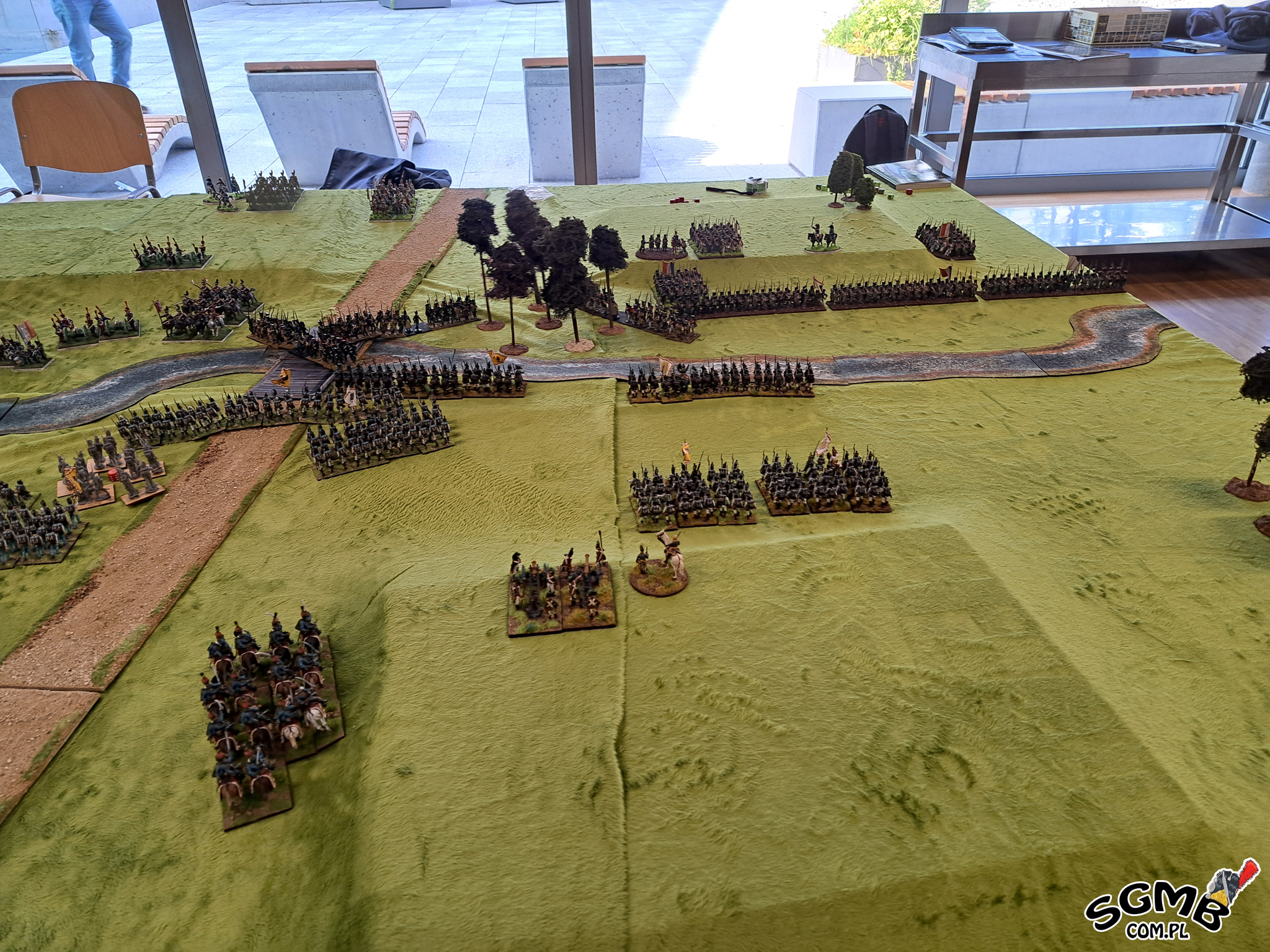
Tura 4. Kolejne Austriackie bataliony zbliżyły się do pozycji Francuskich. Muszkiety strzelają już na całej linii frontu.
Turn 4. More Austrian battalions approached the French positions. Muskets were now firing along the entire front line.
Tura 4. Kolejne Austriackie bataliony zbliżyły się do pozycji Francuskich. Muszkiety strzelają już na całej linii frontu.
Turn 4. More Austrian battalions approached the French positions. Muskets were now firing along the entire front line.
|
Po serii rozkazów, które nie doszły do skutku w końcu na prawej flance Francuzów 4 bataliony rozpoczęły obejście. Wiązane z tym były duże nadzieje, gdyż siły Austriaków wydawały się tutaj łatwiejsze do pokonania.
W miejscu gdzie wycofywała się rozbita brygada szarży dokonał jeden szwadron Ułanów 15 Pułki. Batalion Austriacki sformował Division Masse i odparł szarżę.
Próbę obejścia Austriacy próbowali powstrzymać przemieszczając baterie artylerii konnej i eliminując jeden z batalionów Francuskich. Dodatkowo pozycję wyjściowe do szarży zajęli kirasjerzy. Reszta jednostek pozostawała na swoich pozycach lub kontynuowała wymianę ognia.
|
After a series of orders that failed to materialize, four battalions finally began a bypass on the French right flank. High hopes were pinned on this, as the Austrian forces seemed easier to defeat there.
At the point where the defeated brigade was retreating, a single squadron of the 15th Uhlan Regiment launched a charge. The Austrian battalion formed a Masse Division and repelled the charge.
The Austrians attempted to halt the bypass attempt by moving their horse artillery batteries and eliminating one of the French battalions. Additionally, cuirassiers took up the starting position for the charge. The remaining units remained in their positions or continued the firefight.
|
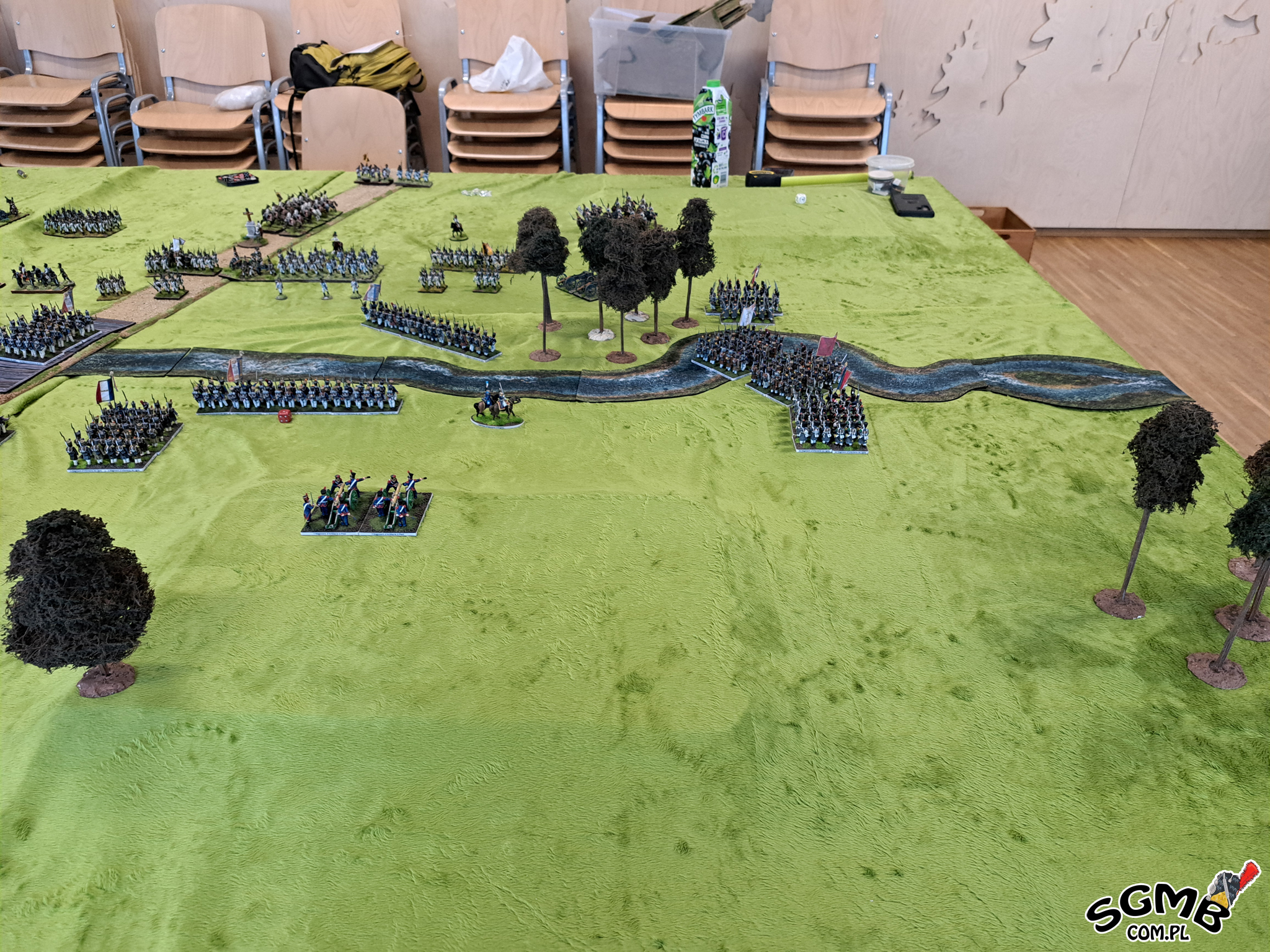
Tura 5. Francuskie bataliony obchodzą pozycje Austriackie. Powinny to zrobić przynajmniej 2 tury wcześniej.
Turn 5. French battalions bypass Austrian positions. They should have done this at least two turns earlier.
Tura 5. Francuskie bataliony obchodzą pozycje Austriackie. Powinny to zrobić przynajmniej 2 tury wcześniej.
Turn 5. French battalions bypass Austrian positions. They should have done this at least two turns earlier.
|
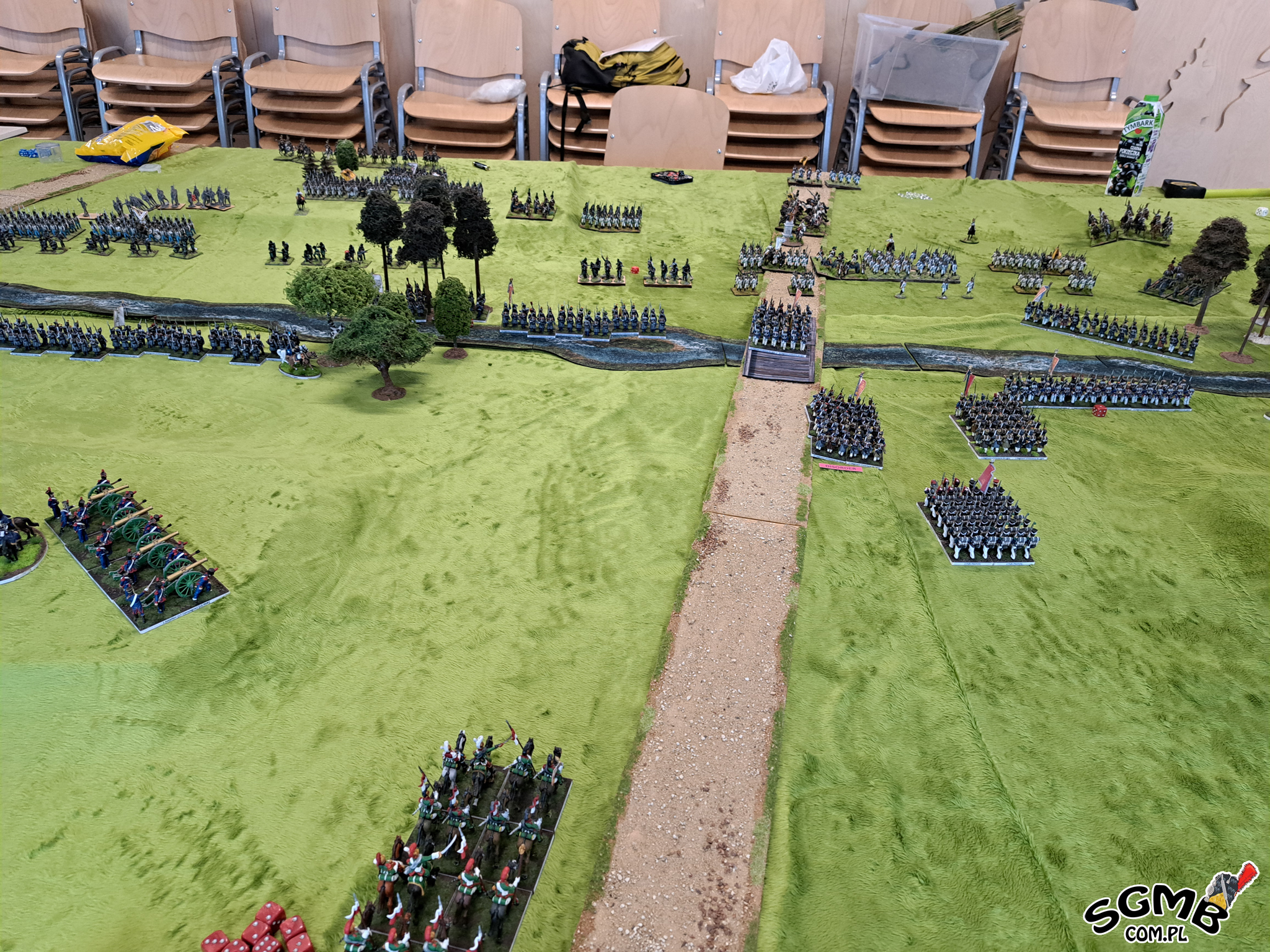
Tura 5. Kolejne Francuskie bataliony docierają do linii Austriackich. Wyjątkowo nieruchliwi byli Francuzi w tej bitwie.
Turn 5. More French battalions reach the Austrian lines. The French were exceptionally immobile in this battle.
Tura 5. Kolejne Francuskie bataliony docierają do linii Austriackich. Wyjątkowo nieruchliwi byli Francuzi w tej bitwie.
Turn 5. More French battalions reach the Austrian lines. The French were exceptionally immobile in this battle.
|
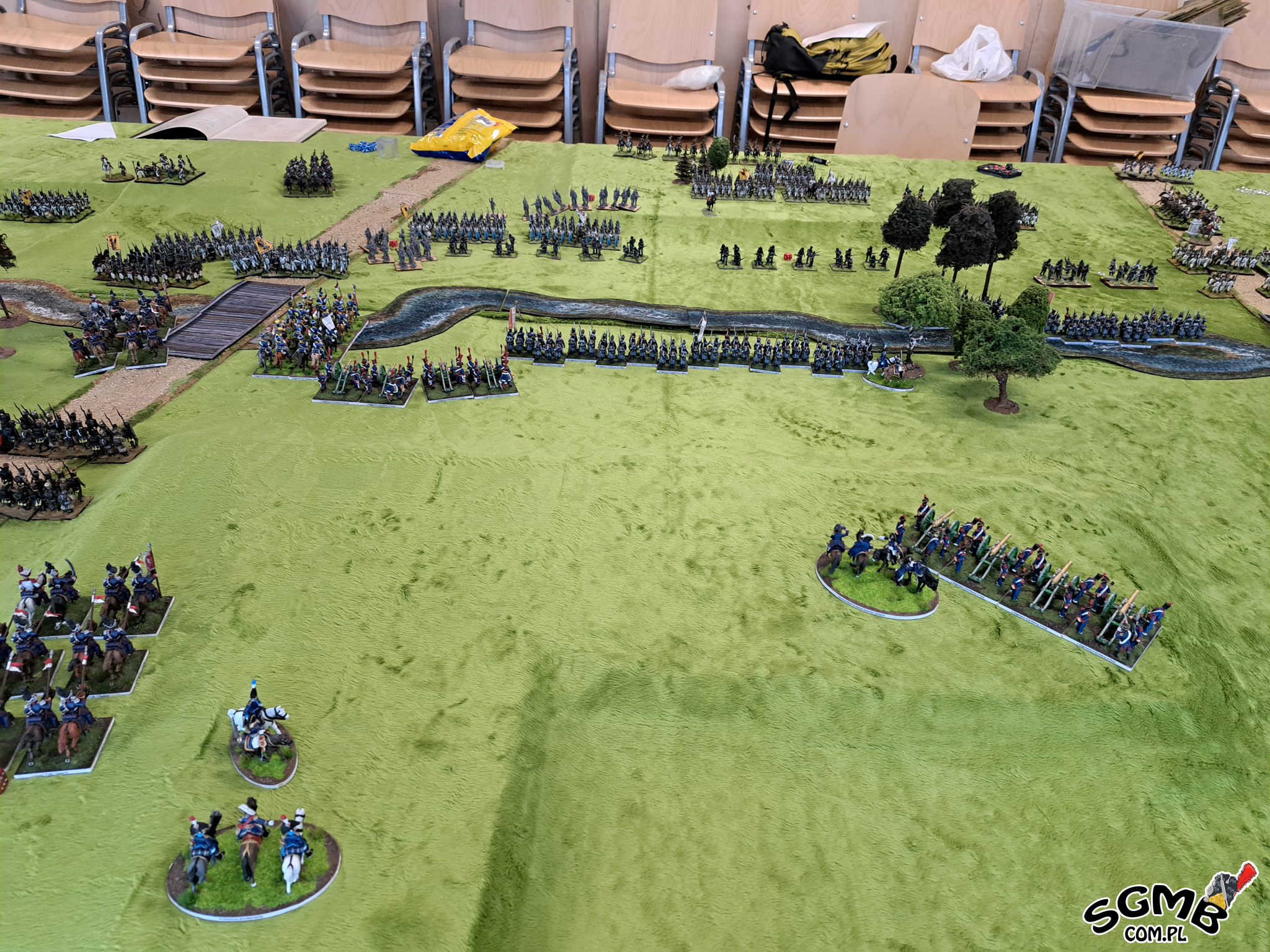
Tura 5. Lekka kawaleria próbowała szarżować, ale nie dojechała do przeciwnika.
Turn 5. The light cavalry tried to charge but did not reach the enemy.
Tura 5. Lekka kawaleria próbowała szarżować, ale nie dojechała do przeciwnika.
Turn 5. The light cavalry tried to charge but did not reach the enemy.
|
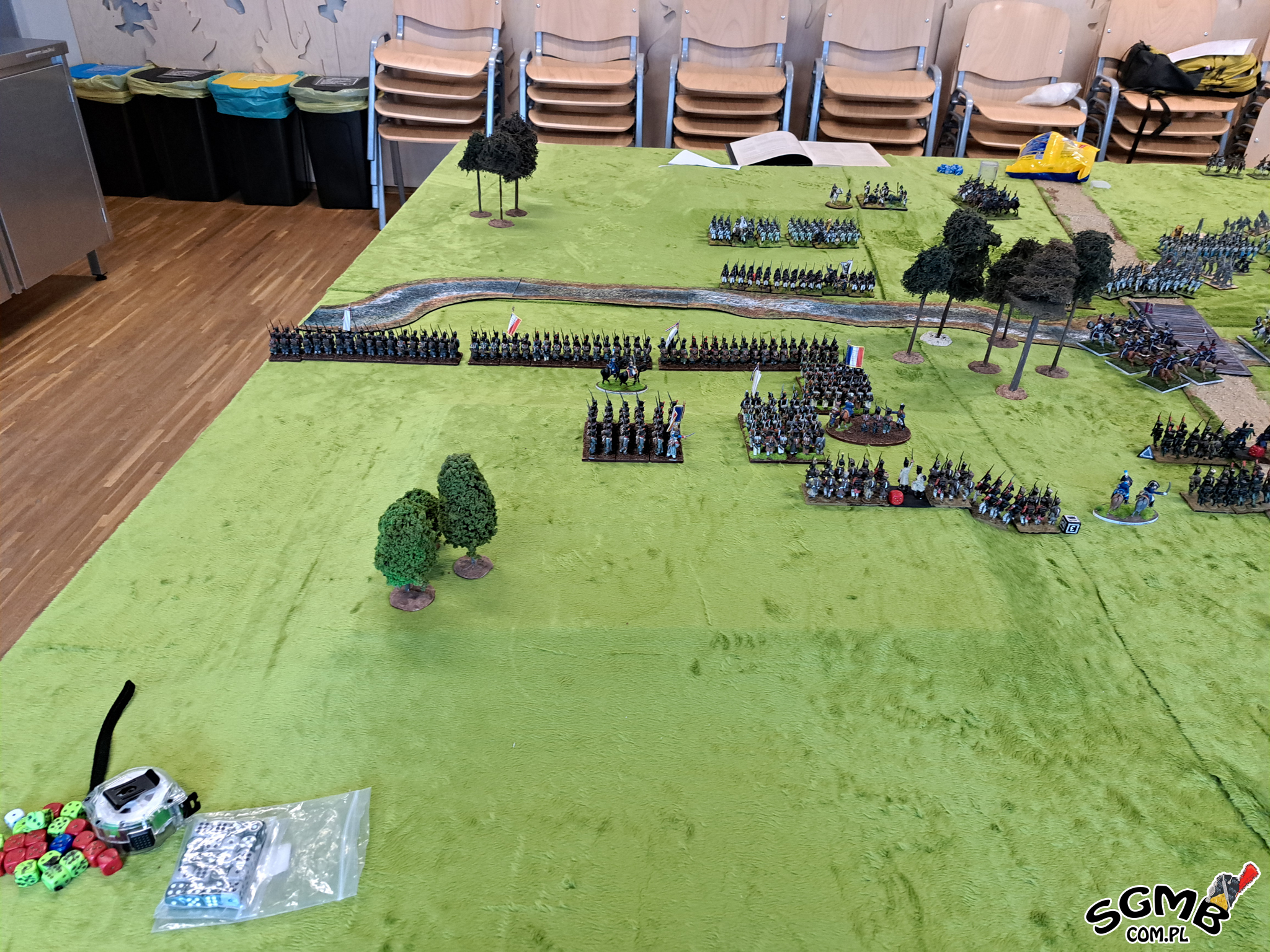
Tura 5. Lewa flanka Francuzów rozwinięta w linie.
Turn 5. The French left flank deployed in lines.
Tura 5. Lewa flanka Francuzów rozwinięta w linie.
Turn 5. The French left flank deployed in lines.
|
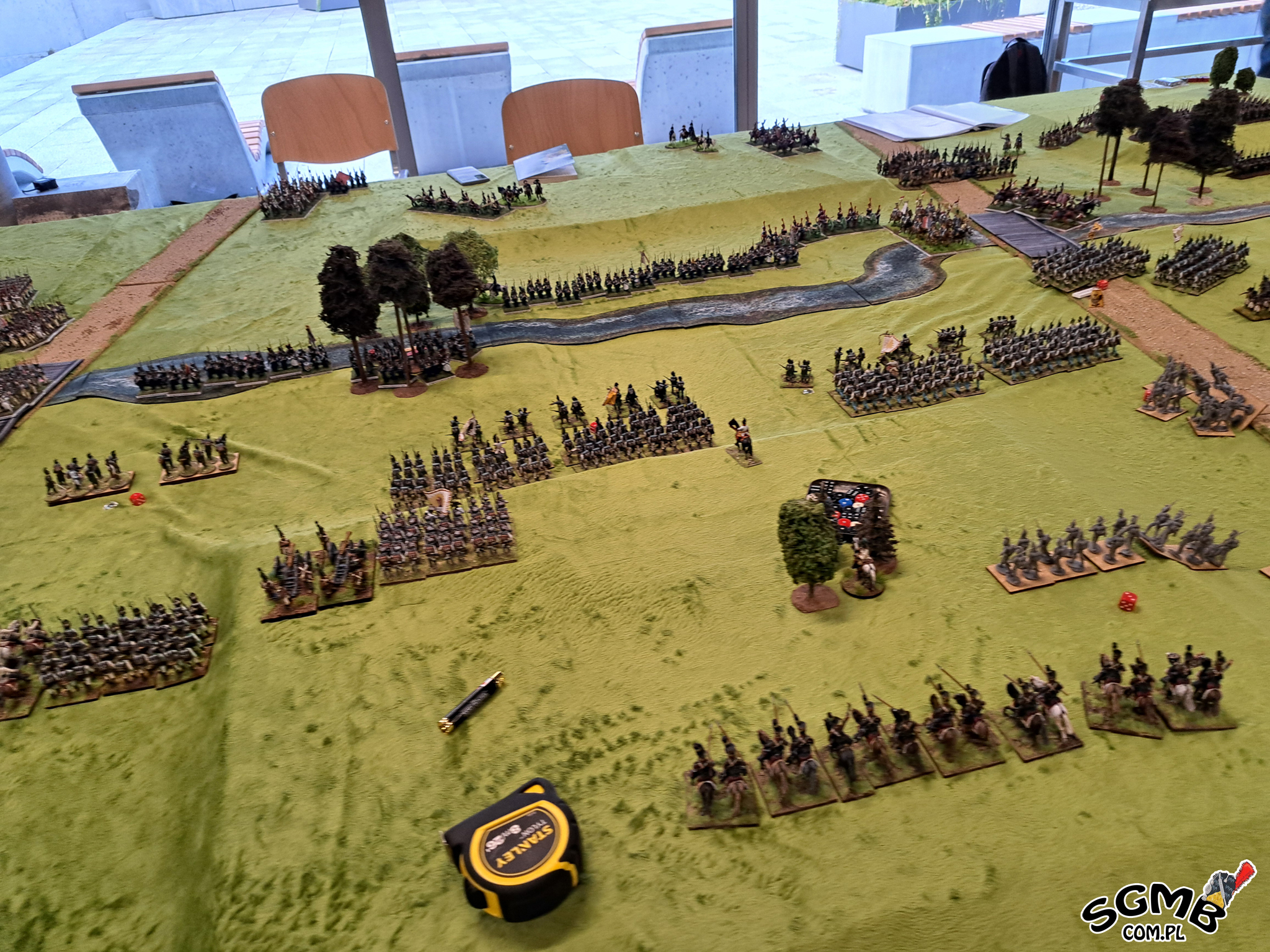
Tura 5. Centrum Austriackie.
Tour 5. Austrian Center.
Tura 5. Centrum Austriackie.
Tour 5. Austrian Center.
|
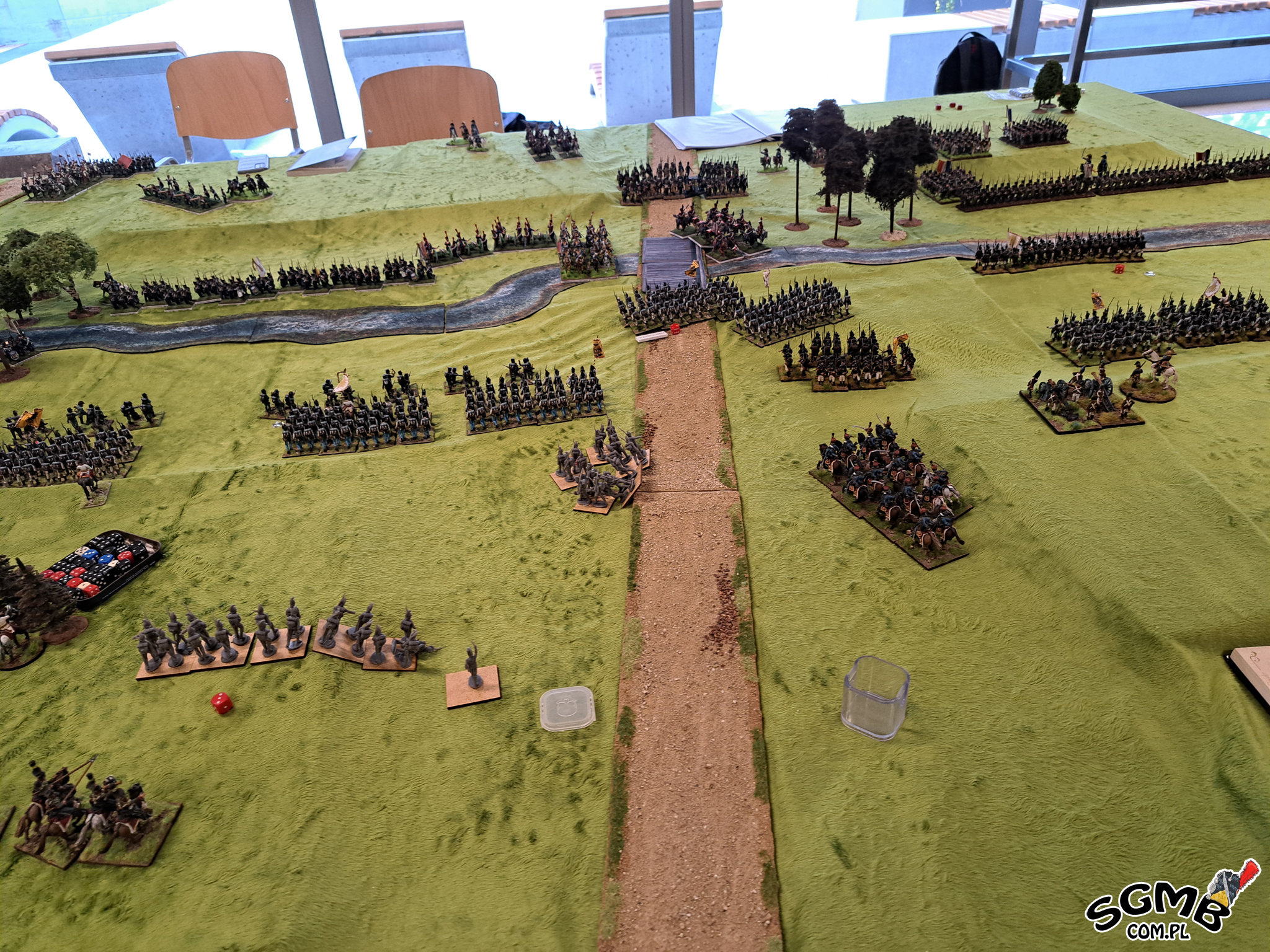
Tura 5. Prawa flanka Austriacka.
Turn 5. Austrian right flank.
Tura 5. Prawa flanka Austriacka.
Turn 5. Austrian right flank.
|
W 6 turze 4 kolejne bataliony Francuskie przeszły przez rzekę na prawej flance. Dużo czasu zajął ten manewr, ale w końcu dawał wymierny rezultat. Na pozostałych odcinkach trwała wymiana ognia.
Lewa flanka wojsk Francuskich, która do tej pory głównie zmieniała formacje i czasem pojedynczy batalion oddał salwę, powoli ruszyła do obejścia podobnego na prawej flance.
Wcześniej ostrożna ze względu na bliskość Huzarów miała teraz trochę miejsca na ten manewr.
Austriacki dowódca widząc co dzieje się na flankach i widząc zagrożenie na całym froncie pchnął przed siebie piechotę ta rozwijając się w linię rozpoczęła morderczy ostrzał.
Do przodu przesunęła się również kawaleria, czekając na dogodny czas i miejsce do szarży.
|
In the sixth round, four more French battalions crossed the river on the right flank. This maneuver took a long time, but eventually yielded tangible results. Firefights continued on the remaining sections.
The left flank of the French forces, which until then had mainly been changing formations, with the occasional single battalion firing a volley, slowly moved to bypass a similar movement on the right flank.
Previously cautious due to the proximity of the Hussars, it now had some room for this maneuver.
The Austrian commander, seeing what was happening on the flanks and the threat along the entire front, pushed the infantry forward. The infantry, forming a line, began a murderous barrage.
The cavalry also moved forward, waiting for the right time and place to charge.
|
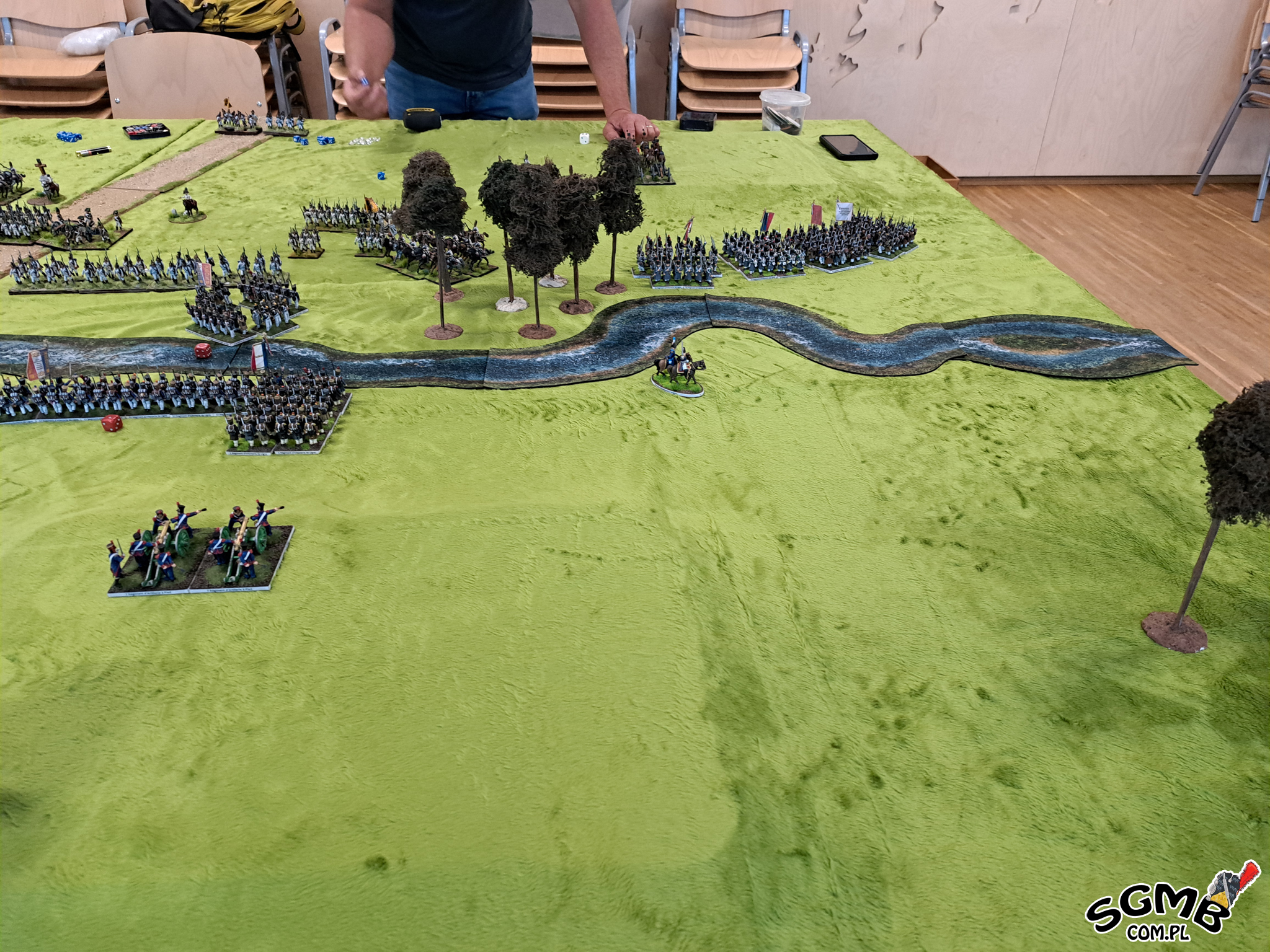
Tura 6. Francuzi rozpoczynają rolowanie frontu.
Turn 6. The French begin rolling the front.
Tura 6. Francuzi rozpoczynają rolowanie frontu.
Turn 6. The French begin rolling the front.
|
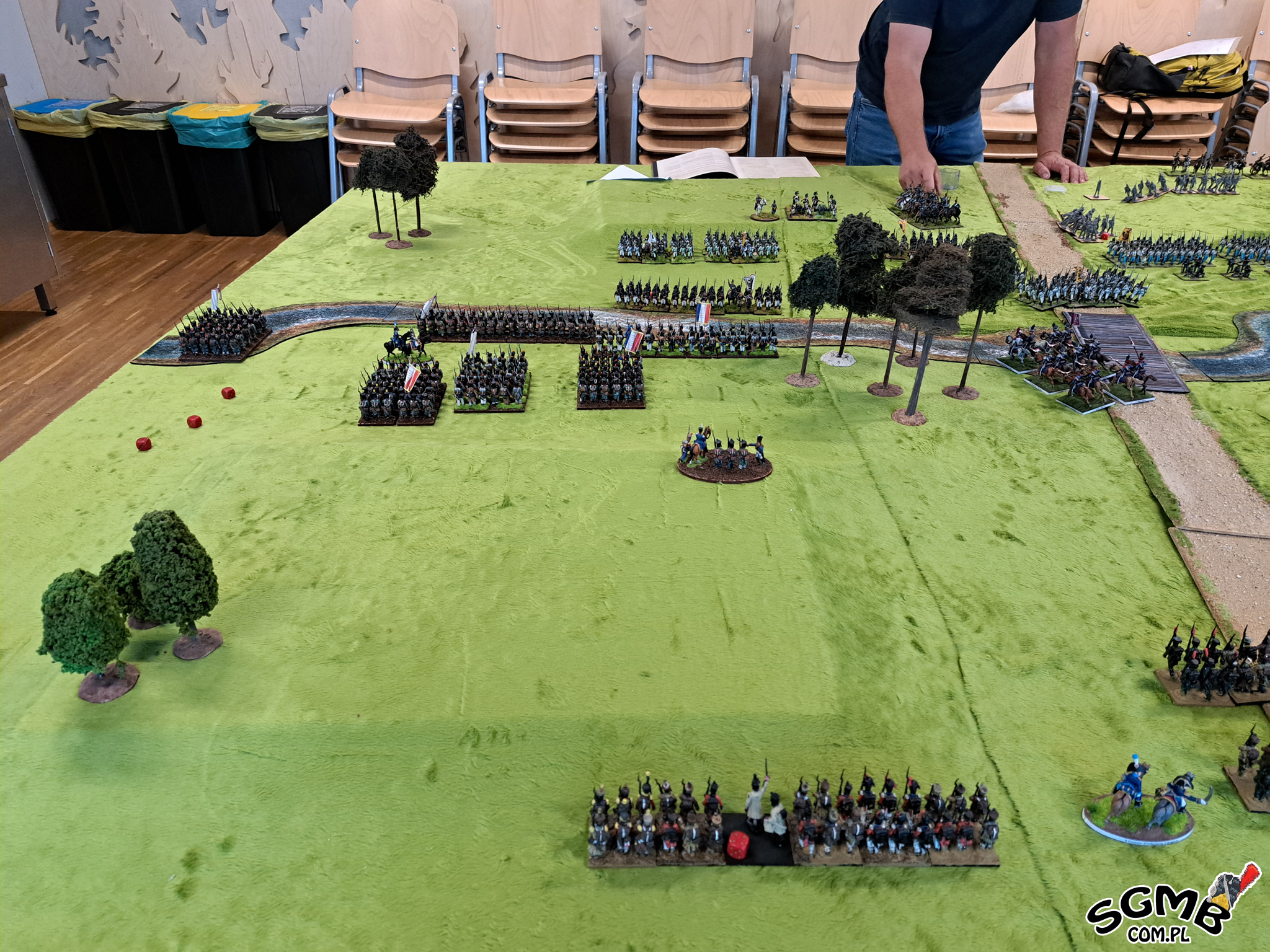
Tura 6. Lewa flanka dalej bardzo ostrożnie.
Turn 6. Left flank continues very carefully.
Tura 6. Lewa flanka dalej bardzo ostrożnie.
Turn 6. Left flank continues very carefully.
|
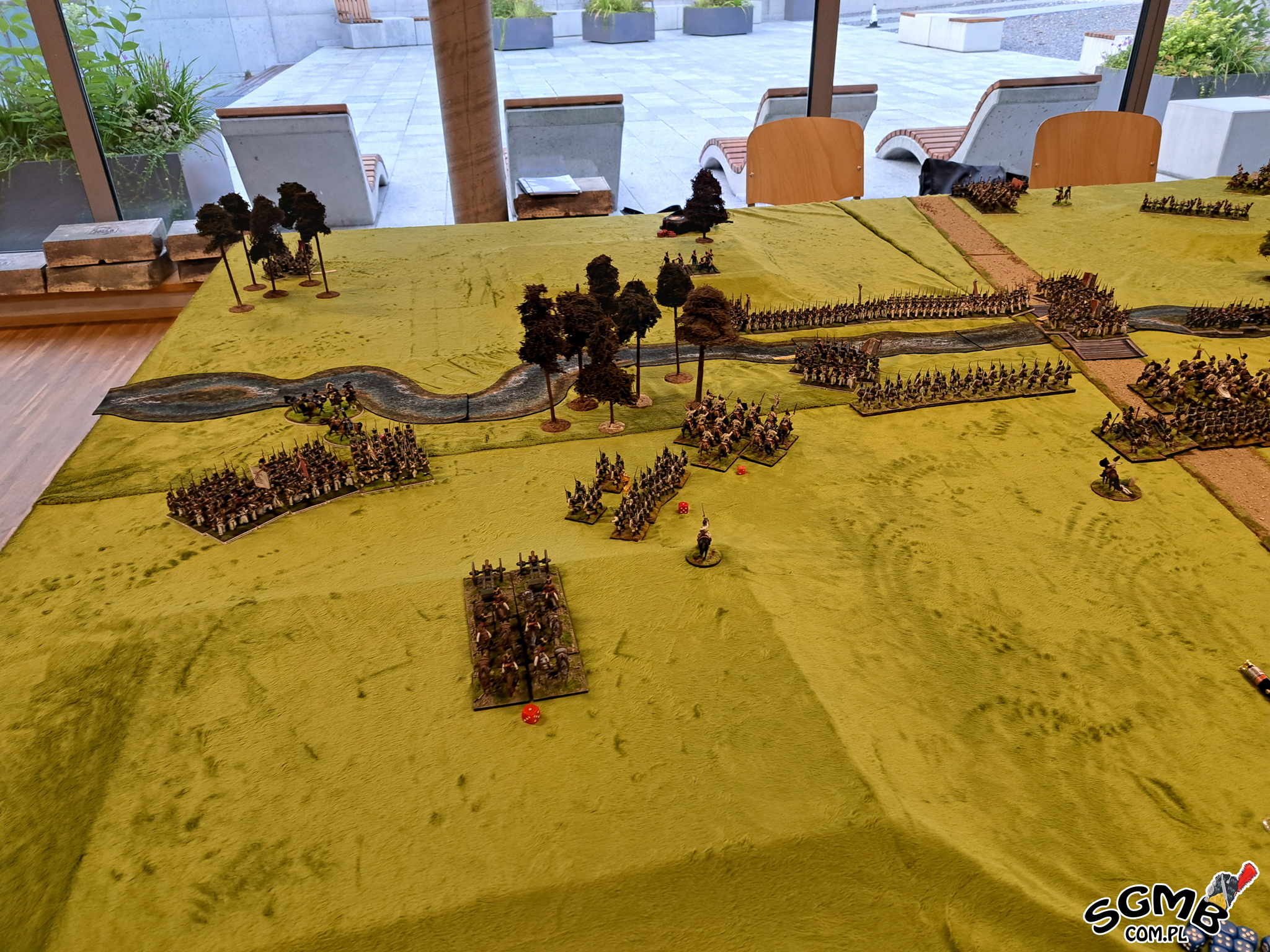
Tura 6. Austriacy wydzielają jeden batalion i artylerię konną do ratowania flanki.
Turn 6. The Austrians dedicate one battalion and horse artillery to save the flank.
Turn 6. The Austrians dedicate one battalion and horse artillery to save the flank.
Turn 6. As you can see, most of the 8th division had no desire to fight today.
|
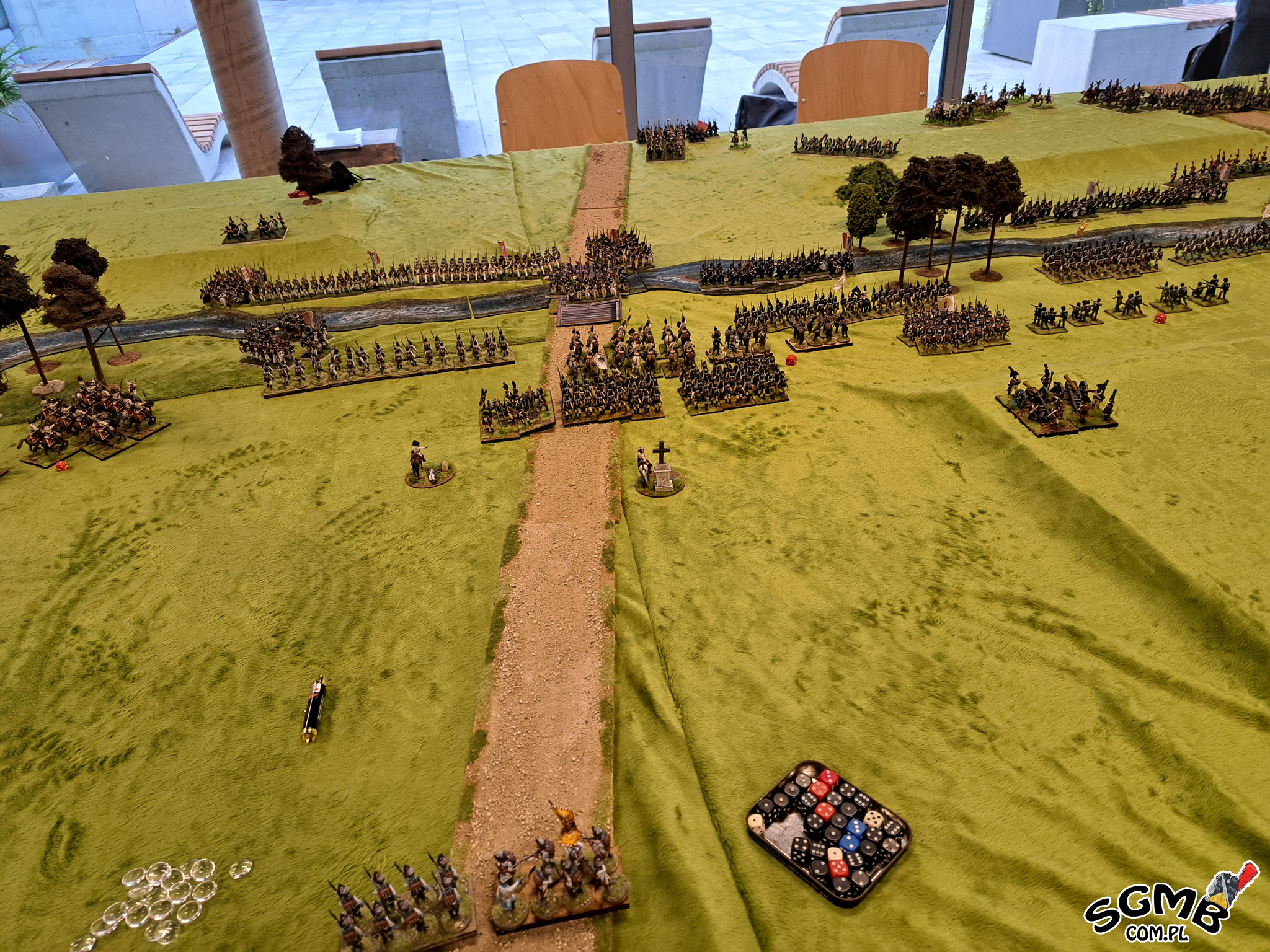
Tura 6. W centrum piechota pchnięta do przodu. Zwiększyło to siłę ognia.
Turn 6. In the center, the infantry was pushed forward. Increasing firepower.
Tura 6. W centrum piechota pchnięta do przodu. Zwiększyło to siłę ognia.
Turn 6. In the center, the infantry was pushed forward. Increasing firepower.
|
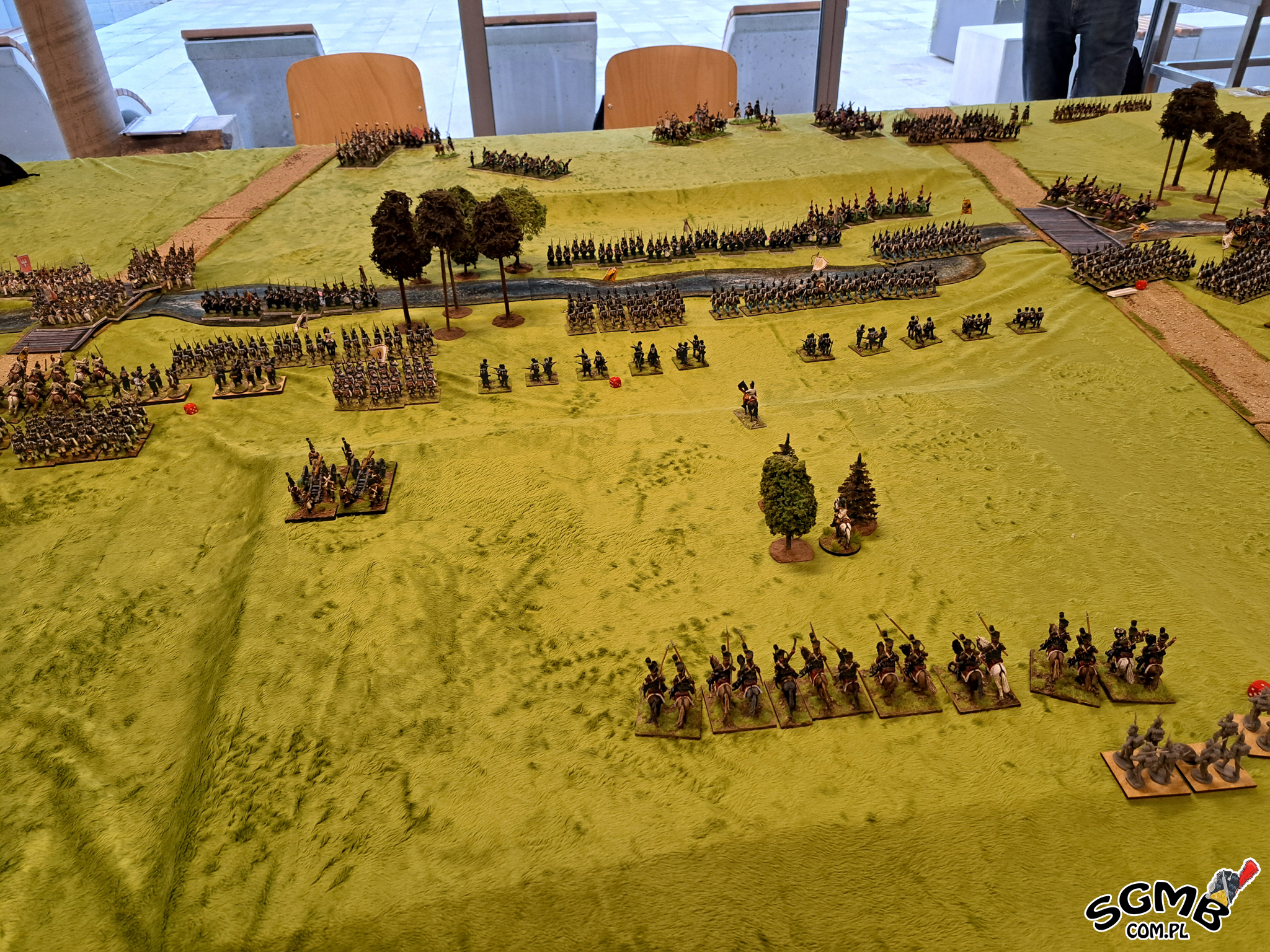
Tura 6. W centrum piechota pchnięta do przodu. Zwiększyło to siłę ognia.
Turn 6. In the center, the infantry was pushed forward. Increasing firepower.
Tura 6. W centrum piechota pchnięta do przodu. Zwiększyło to siłę ognia.
Turn 6. In the center, the infantry was pushed forward. Increasing firepower.
|
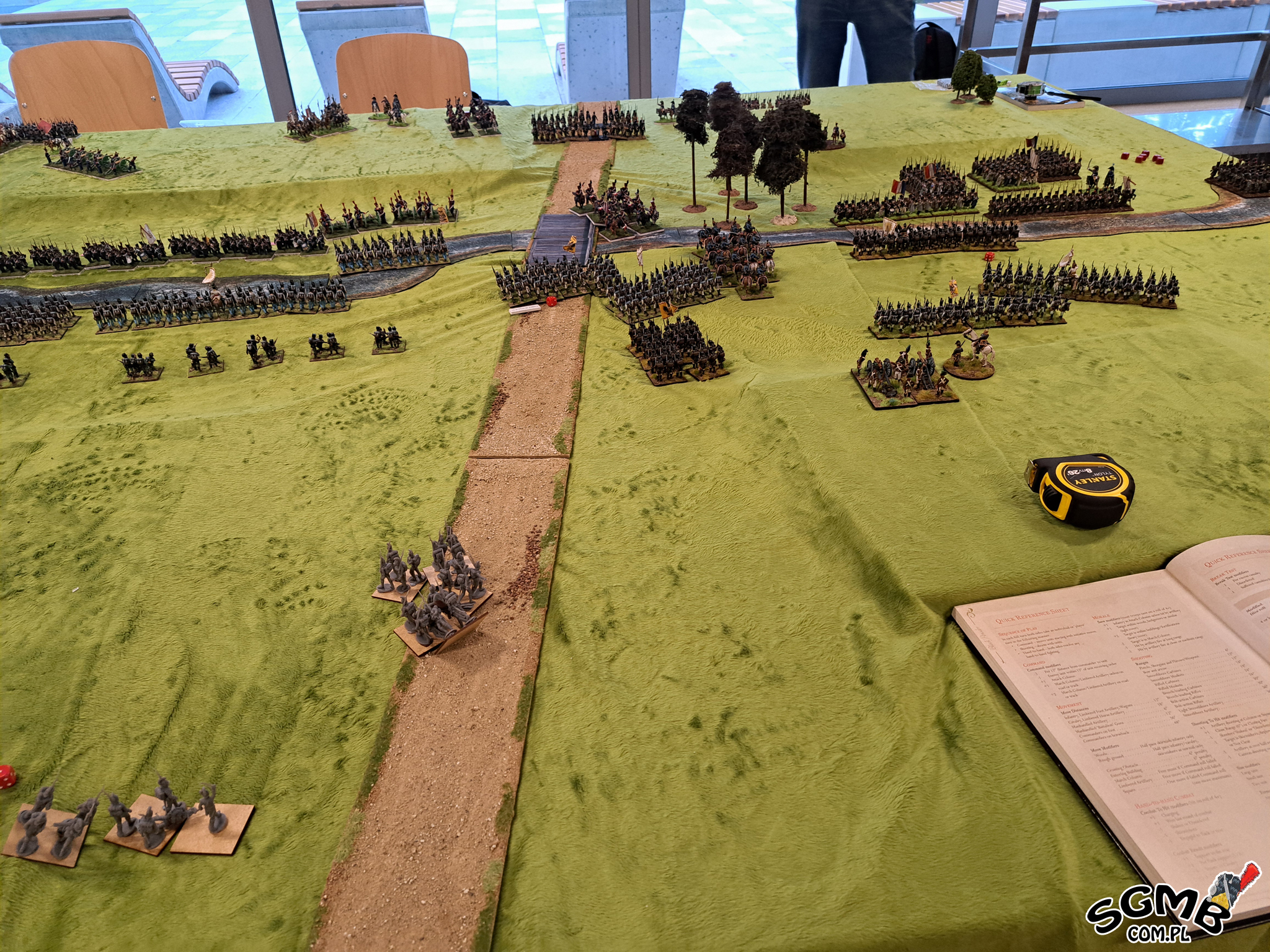
Tura 6. W centrum piechota pchnięta do przodu. Zwiększyło to siłę ognia.
Turn 6. In the center, the infantry was pushed forward. Increasing firepower.
Tura 6. W centrum piechota pchnięta do przodu. Zwiększyło to siłę ognia.
Turn 6. In the center, the infantry was pushed forward. Increasing firepower.
|
Pchane do przodu bataliony Francuskie na prawym skrzydle rozstrzelały Austriacką artylerię konną i otwarły sobie pozycje do rolowania frontu.
W środkowej części pola bitwy siły Francuskie ostrzał już na bliskim dystansie (po podejściu nowych sił austriackich w poprzedniej rundzie).
Ciężka artyleria widząc nadciągające masy dokonała zwrotu i teraz mogła razić przeciwnika nadchodzącego wprost przed nią. Niestety po raz kolejny nie popisała się brygada kawalerii nie wykonując swoich rozkazów.
Do szarży ruszyli Kirasjerzy Austriaccy jednak zostali oni zdezorganizowani ostrzałem z czworoboku obok którego przejeżdżali i nie dojechali do celu swojej szarży.
Po drugiej stronie Huzarzy zaszarżowali Polskich Ułanów. Starcie to wygrali, a kontynuując szarżę wpadli na artylerię konną i znieśli jedną kompanię.
Między wojskami Francuskimi powstała niebezpieczna wyrwa.
|
The French battalions pushed forward on the right flank routed the Austrian horse artillery and opened up positions for a rollback.
In the central part of the battlefield, the French forces were already firing at close range (after the approach of new Austrian forces in the previous round).
The heavy artillery, seeing the approaching masses, turned and could now engage the enemy approaching directly in front of them. Unfortunately, the cavalry brigade once again failed to perform, disobeying its orders.
The Austrian Cuirassiers charged, but they were disorganized by fire from the square they were passing and failed to reach the target of their charge.
On the other side, the Hussars charged the Polish Uhlans. They won the engagement, and as they continued their charge, they ran into the horse artillery and took out one company.
A dangerous gap opened between the French forces.
|
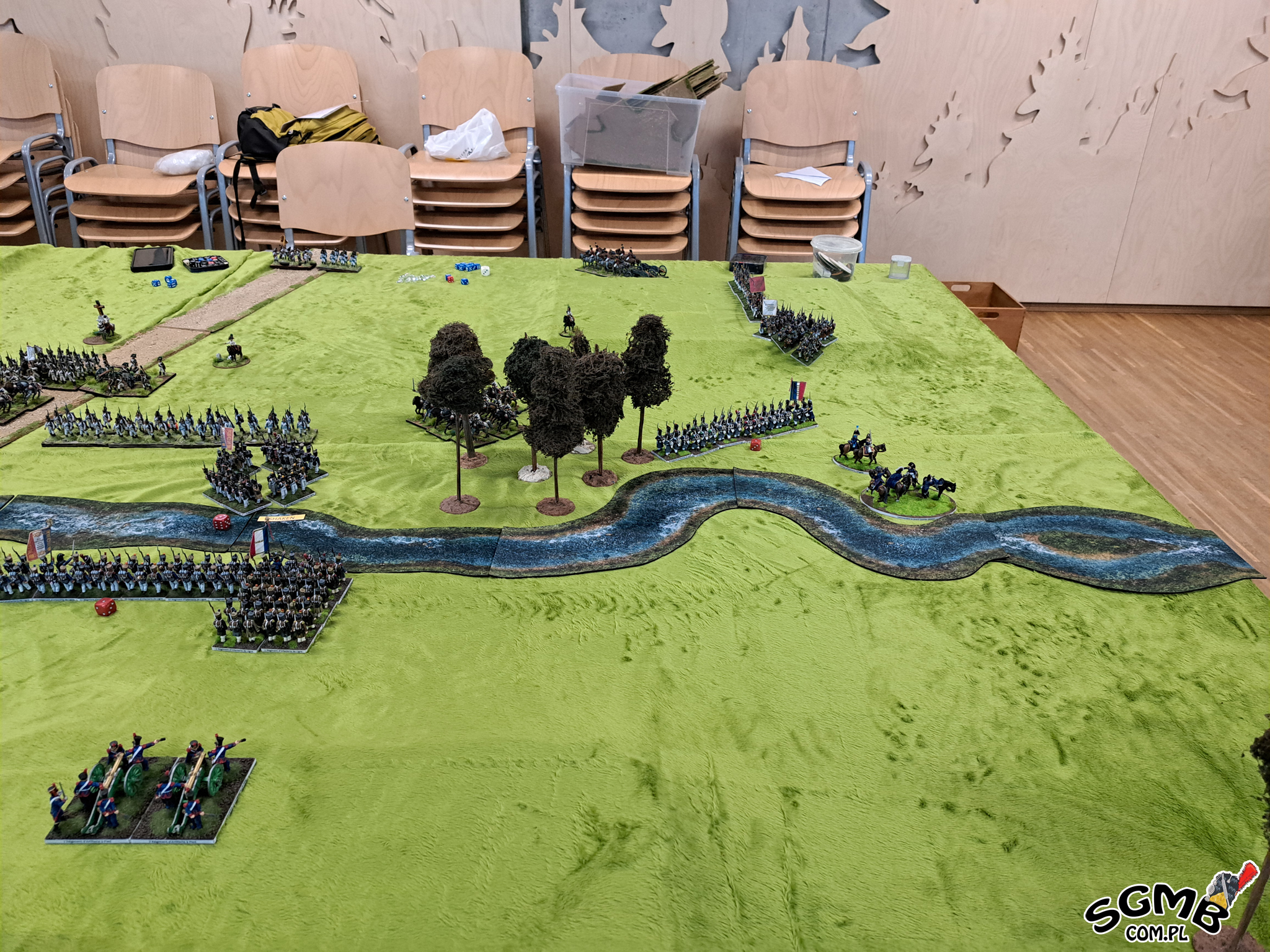
Tura 7. Pod ogniem Francuskich muszkietów ucieka Austriacka Artyleria Konna. Francuzi wychodzą na tyły.
Turn 7. The Austrian Horse Artillery flees under French musket fire. The French move to the rear.
TTura 7. Pod ogniem Francuskich muszkietów ucieka Austriacka Artyleria Konna. Francuzi wychodzą na tyły.
Turn 7. The Austrian Horse Artillery flees under French musket fire. The French move to the rear.
|
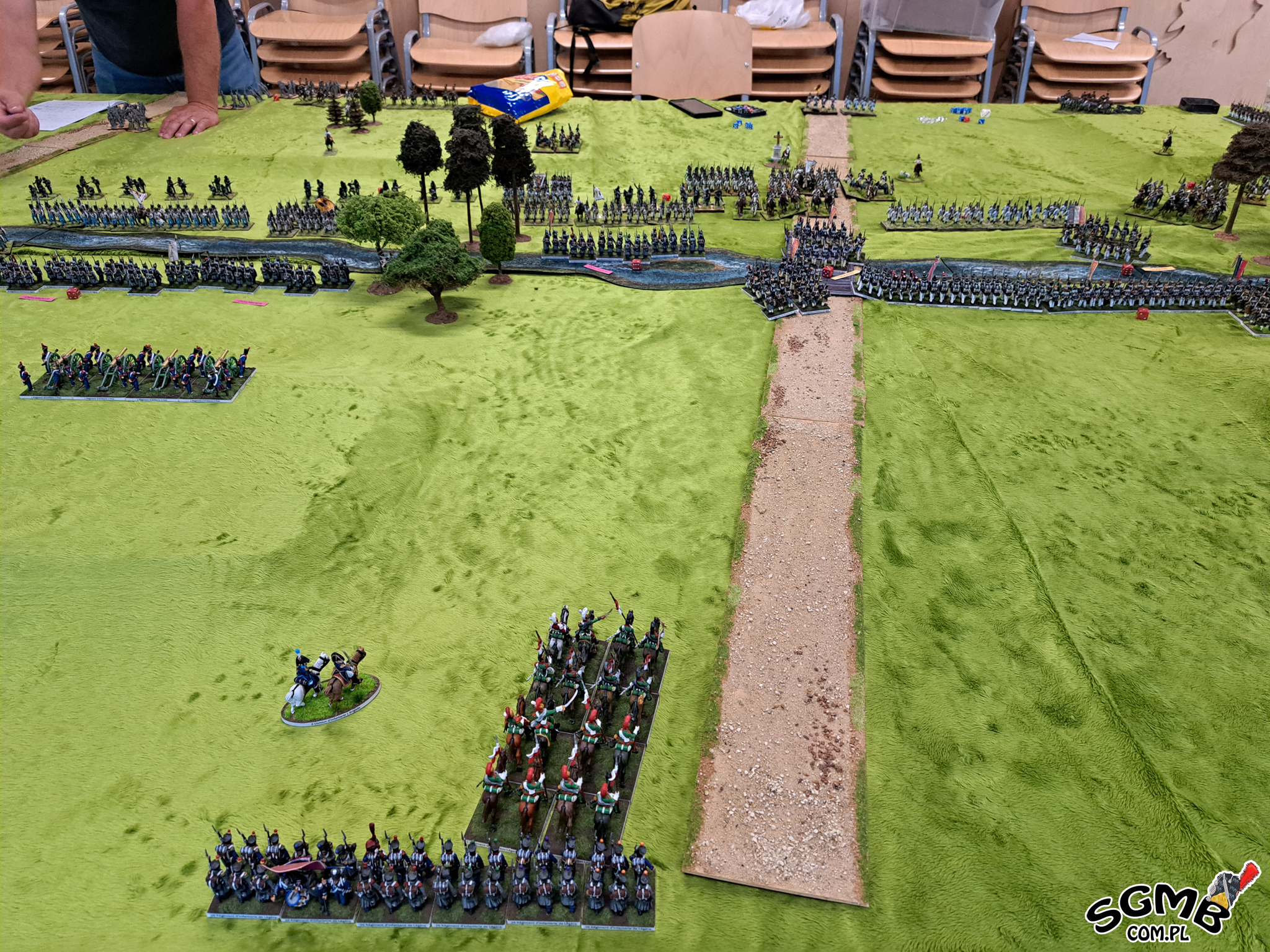
Tura 7. Centrum Francuzów, podobnie jak Austriackie rozwinięte w linie. Z tyłu batalion, który pomylił rozkazy i Kawaleria, której wkład w bitwie może zostać pominięty.
Turn 7. The French center, like the Austrians, was deployed in lines. In the rear, a battalion that had confused its orders and cavalry whose contribution to the battle could be overlooked.
Tura 7. Centrum Francuzów, podobnie jak Austriackie rozwinięte w linie. Z tyłu batalion, który pomylił rozkazy i Kawaleria, której wkład w bitwie może zostać pominięty.
Turn 7. The French center, like the Austrians, was deployed in lines. In the rear, a battalion that had confused its orders and cavalry whose contribution to the battle could be overlooked.
|
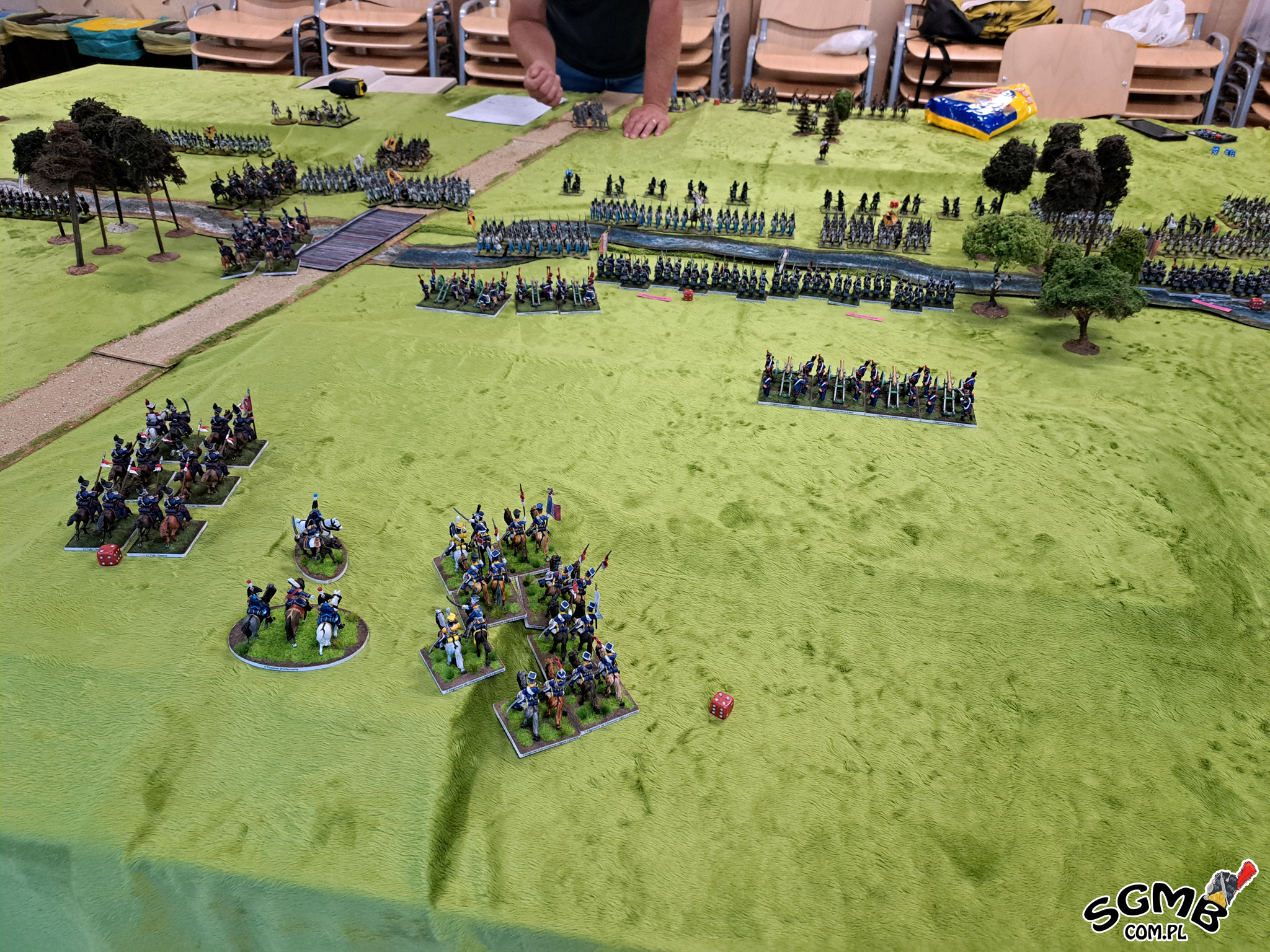
Tura 7. Centrum Francuzów, podobnie jak Austriackie rozwinięte w linie. Z tyłu Kawaleria, której wkład w bitwie może zostać pominięty.
Turn 7. The French center, like the Austrians, was deployed in lines. In the rear cavalry whose contribution to the battle could be overlooked.
Tura 7. Centrum Francuzów, podobnie jak Austriackie rozwinięte w linie. Z tyłu Kawaleria, której wkład w bitwie może zostać pominięty.
Turn 7. The French center, like the Austrians, was deployed in lines. In the rear cavalry whose contribution to the battle could be overlooked.
|
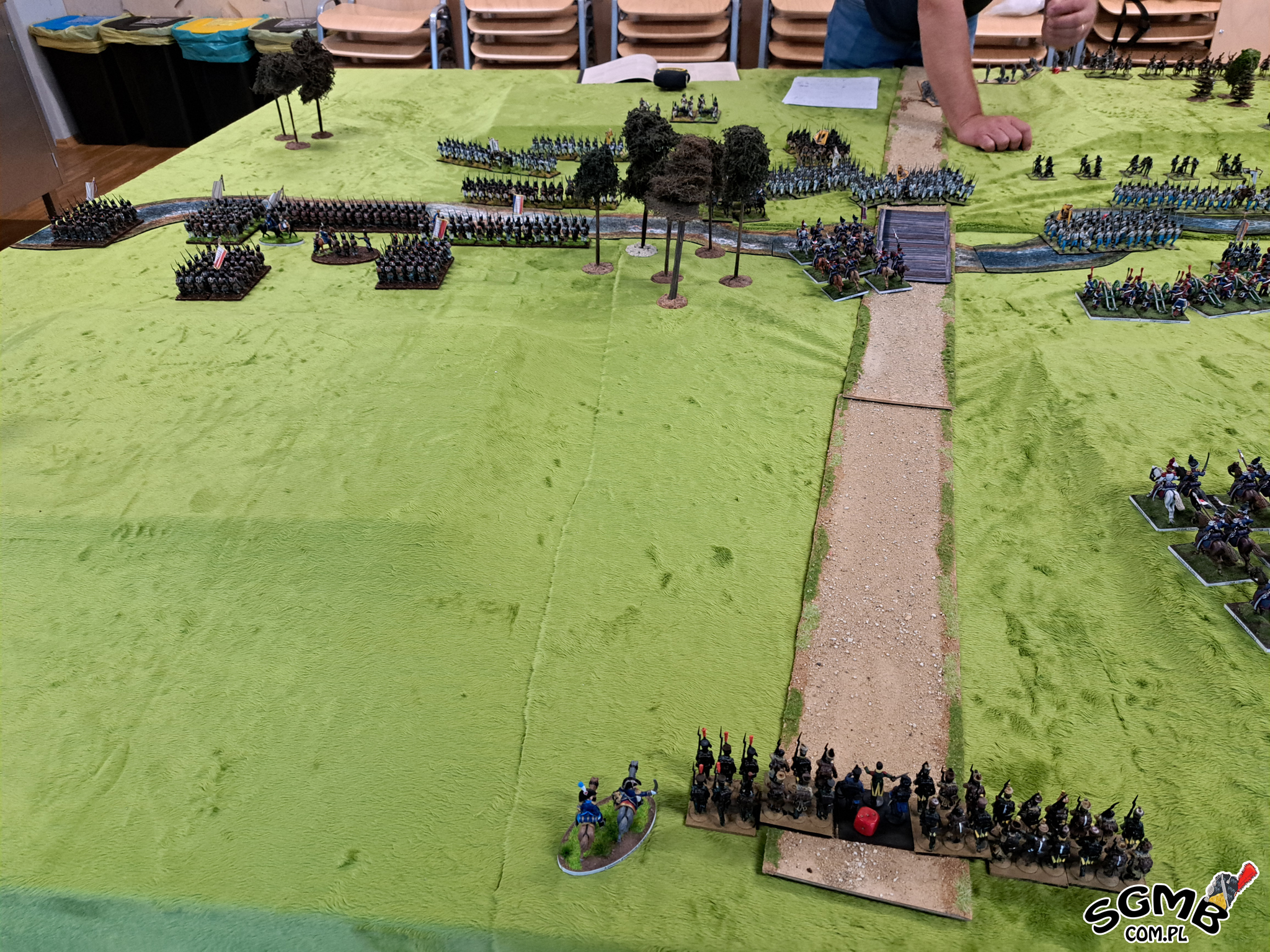
Tura 6. Lewa flanka dalej bardzo ostrożnie.
Turn 6. Left flank continues very carefully.
Tura 6. Lewa flanka dalej bardzo ostrożnie.
Turn 6. Left flank continues very carefully.
|
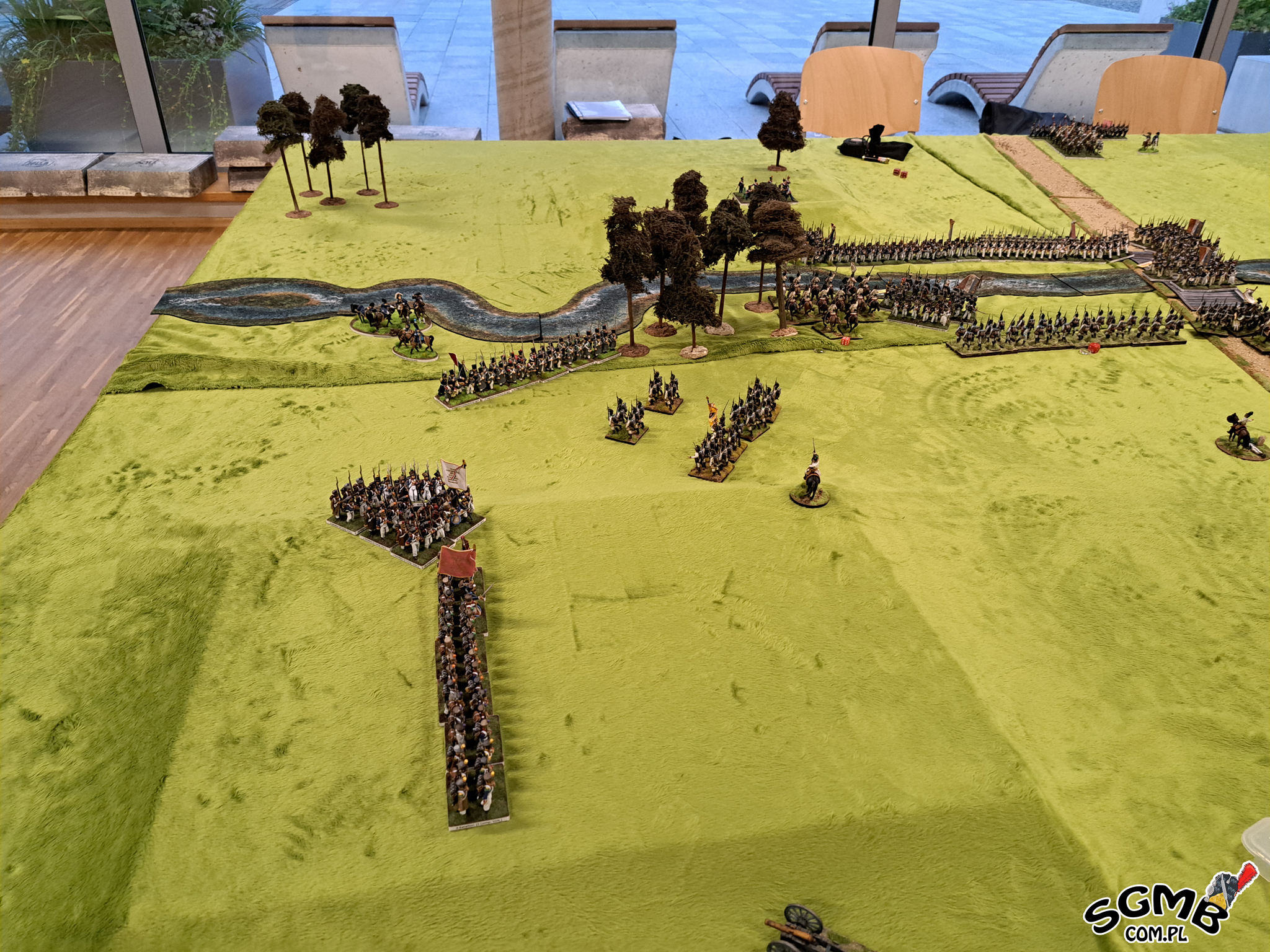
Tura 7. Nieudana szarża Kirasjerów Austriackich.
Turn 7. Unsuccessful charge of the Austrian Cuirassiers.
Tura 7. Nieudana szarża Kirasjerów Austriackich.
Turn 7. Unsuccessful charge of the Austrian Cuirassiers.
|
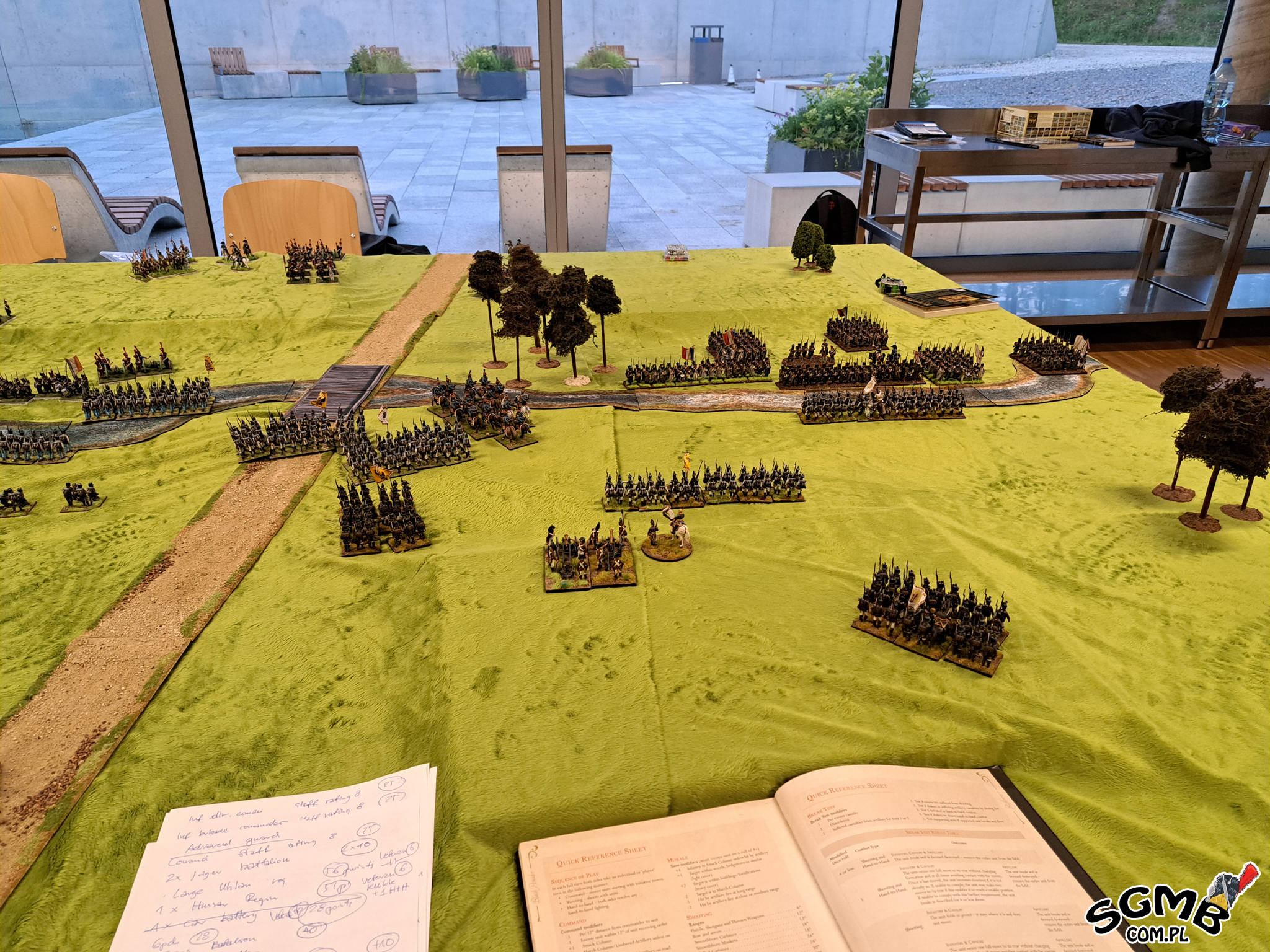
Tura 7. Szarża Huzarów Austriackich spędza z pola Ułanów Księstwa Warszawskiego i wpada w artylerię konną. Powstaje pusta przestrzeń między dwiema dywizjami Francuskimi.
Turn 7. The Austrian Hussars' charge drives the Duchy of Warsaw Uhlans from the field and engages the horse artillery. A gap is created between the two French divisions.
TTura 7. Szarża Huzarów Austriackich spędza z pola Ułanów Księstwa Warszawskiego i wpada w artylerię konną. Powstaje pusta przestrzeń między dwiema dywizjami Francuskimi.
Turn 7. The Austrian Hussars' charge drives the Duchy of Warsaw Uhlans from the field and engages the horse artillery. A gap is created between the two French divisions.
|
Niestety z racji tego, że godzina była późna musieliśmy skończyć. Wielka szkoda, że nie udało się dograć bitwy do końca, gdyż właśnie wchodziła w decydującą fazę.
Z jednej strony Francuzom udało się oskrzydlić Austriaków. Zdrugiej strony Austriacy zrobili wyrwę w liniach Francuskich. Byłaby ona łatwa do załatania, ale mogłaby to zrobić tylko zawodna podczas całej bitwy brygada kawalerii.
Straty Francuskie:
6 batalionów piechoty, 1 szwadron kawalerii, 1 kompania artylerii konnej
Straty Austriackie:
2 bataliony piechoty, 1 szwadron kawalerii, 1 bateria artylerii konnej
|
Unfortunately, due to the late hour, we had to call it a day. It's a great pity that the battle wasn't completed, as it was entering its decisive phase.
On one side, the French managed to outflank the Austrians. On the other, the Austrians had created a breach in the French lines. This would have been easy to fill, but only the cavalry brigade, unreliable throughout the battle, could have done so.
French Losses:
6 infantry battalions, 1 cavalry squadron, 1 horse artillery company
Austrian Losses:
2 infantry battalions, 1 cavalry squadron, 1 horse artillery battery
|
Analiza po bitwie:
Francja
- Popełniony został błąd w rozstawieniu. Kawalerię można było rozstawić na prawej flance gdzie nie było nic na przeciw. Jeśli zdałaby rozkazy, szybciej przekroczyłaby rzekę i mogła siać zamęt na tyłach Austriaków.
- Kiepskie rzuty na rozkazy praktycznie wyeliminowały z walki kawalerię, a obejście na prawej flance ciągnęło się niemiłosiernie długo.
- Lewa flanka zachowywała się dość zachowawczo przez co nie został wykorzystany jej potencjał.
- Trudne było manewrowanie kilkoma pułkami w brygadzie, gdy musiały poruszać się w różnych kierunkach.
- Dobrze wykorzystana została lekka piechota w centrum.
Austria i Rosja
- Austriacy nie wykorzystali przewagi w centrum bitwy gdzie głównie operowali Jegrzy. Gdyby podciągnęli bataliony z tyłu, a nie polegali tylko na jegrach i piechocie Wirtemberskiej mieli na tym odcinku przewagę ponad 3:1.
Przy przewadze w wielkości batalionów (Standardowe Francuskie vs wielkie Austriackie) można było szybko osiągnąć przełamanie.
- Po złamaniu jednej z brygad Francuskich powinni wejść w wyrwę po niej i obsadzić las jegrami, przejęliby wtedy inicjatywę na tym odcinku.
|
|
Post-battle analysis:
French
- A mistake was made in the deployment. The cavalry could have been deployed on the right flank, where there was nothing to oppose them. If they had followed orders, they would have crossed the river faster and could have wreaked havoc in the Austrian rear.
- Poor rolls on orders practically eliminated the cavalry from the fight, and the detour on the right flank dragged on for an inordinately long time.
- The left flank behaved rather conservatively, thus failing to utilize its potential.
- It was difficult to maneuver several regiments in a brigade when they had to move in different directions.
- The light infantry in the center was well utilized.
Austria
- The Austrians failed to capitalize on their advantage in the heart of the battle, where the Jaegers were primarily operating. If they had drawn up battalions from the rear, rather than relying solely on the Jaegers and Württemberg infantry, they would have had a 3:1 advantage in this sector.
With the advantage in battalion size (Standard French vs. large Austrian), a breakthrough could have been achieved quickly.
- After breaking through one of the French brigades, they should have entered the gap left behind and filled the forest with Jaegers; they would then have taken the initiative in this sector.
|
|
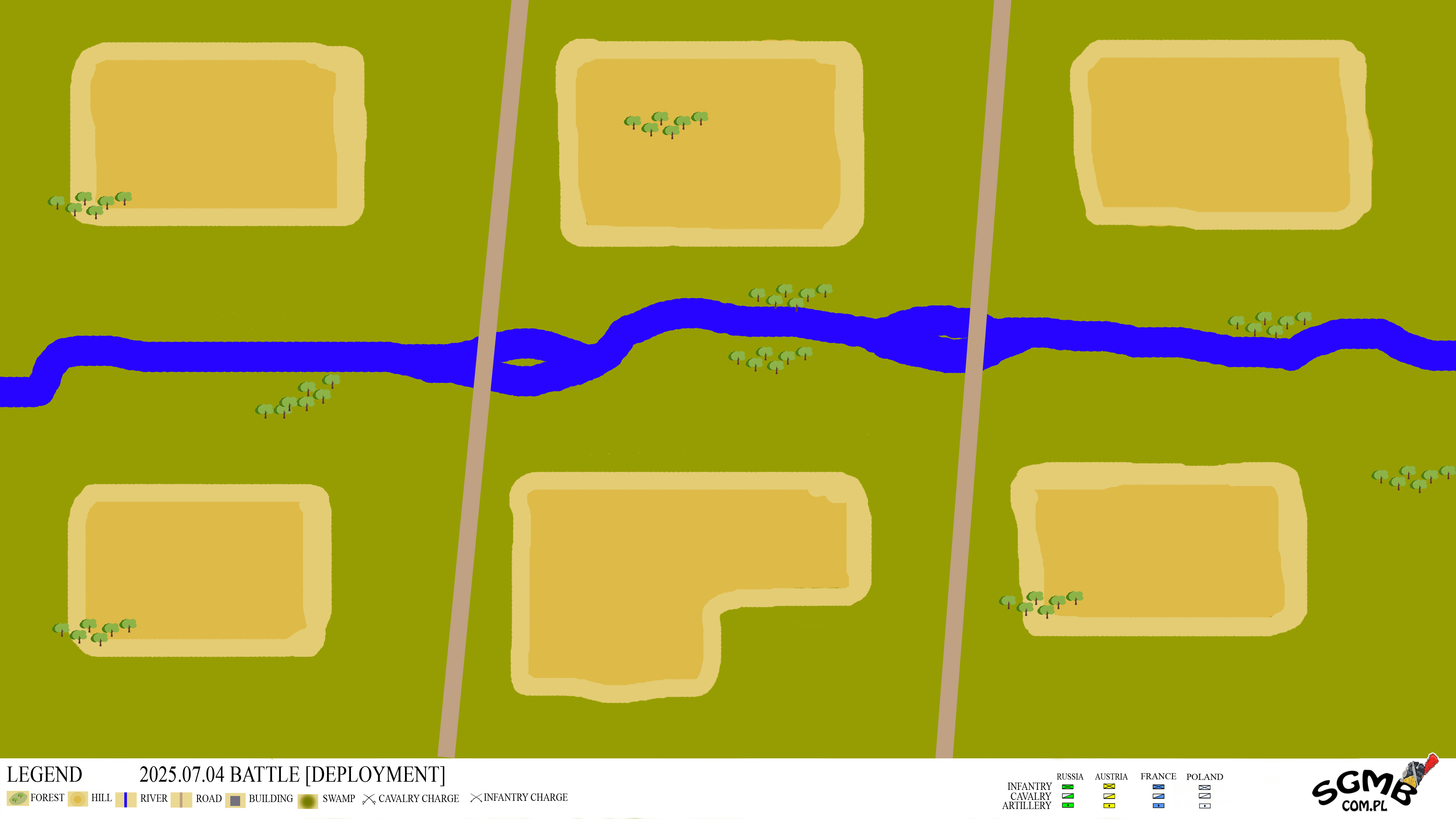 Pole Bitwy.
Pole Bitwy.


































































